From a historical perspective, modern culture and technology have been extensively built on passivated materials, like concrete, steel, plywood or glass, resulting in anthropogenic ecological crises. The core objective of »Material Form Function« is to overcome this logic, which considers matter as an exploitable, passive and ahistorical substance. Our approach emphasizes the inherent self-activity of (bio-)materials. It serves as a critical intervention towards more livable futures and is embedded in humanistic, scientific, and designerly knowledge and expertise. As we are conducting interdisciplinary research on and with materials like air, sand, cellulose, fish-skins, rubber or phase-changing waxes, the troubling reality of the planetary condition requires us to develop an integrative approach to making. Our aim is to question the modern relationship between the three key terms, ›material‹, ›form‹ and ›function‹, and by doing so exploring conditions of a new culture of the material. To achieve this, we have structured our goals and activities around three key missions: Material Legacies, Urgencies of Making, and Beyond Functionality.

Exhibition Opening »Airbound«, 19 October 2023. Copyright: Matters of Activity

Copyright: Mina Mahouti

»Dissect« Event at Tieranatomisches Theater Berlin, 02.11.2022. Foto: Alexandra Ruppert. Copyright: Matters of Activity

»Material Trajectories. Designing with Care« Annual Conference of the Annual Conference of the German Society for Design Theory and Research (DGTF). Copyright: DGTF
Experimental Settings















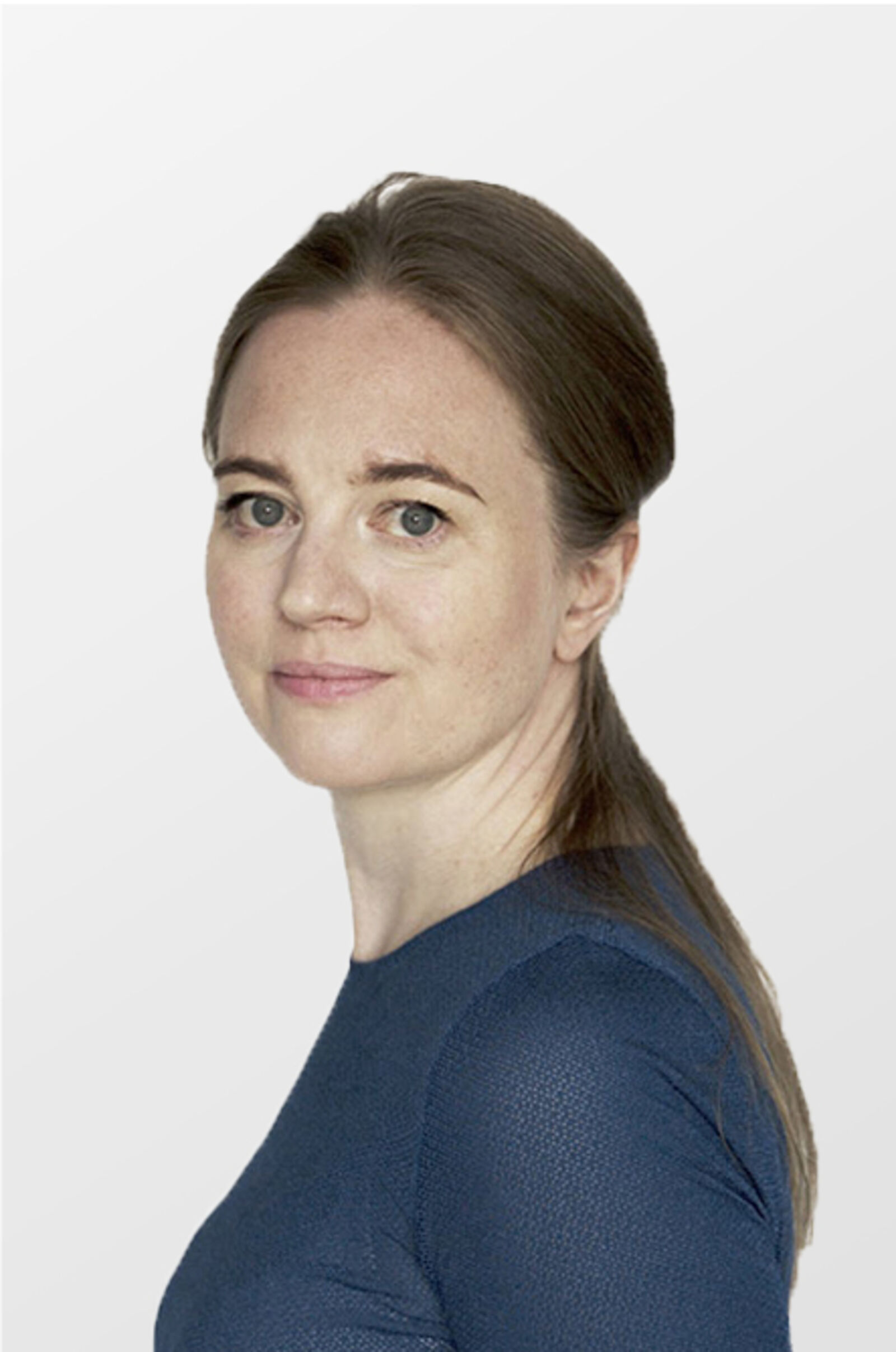











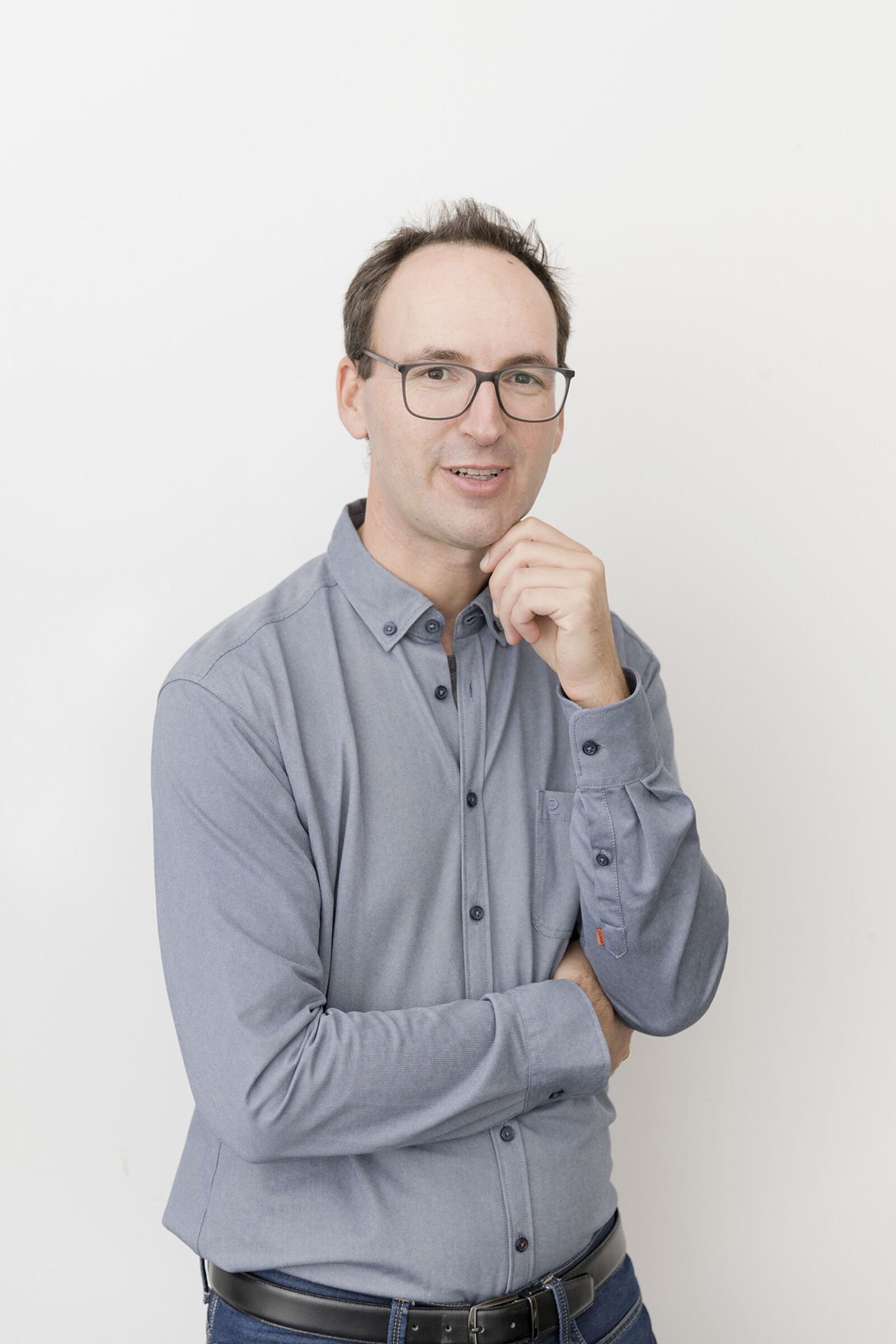


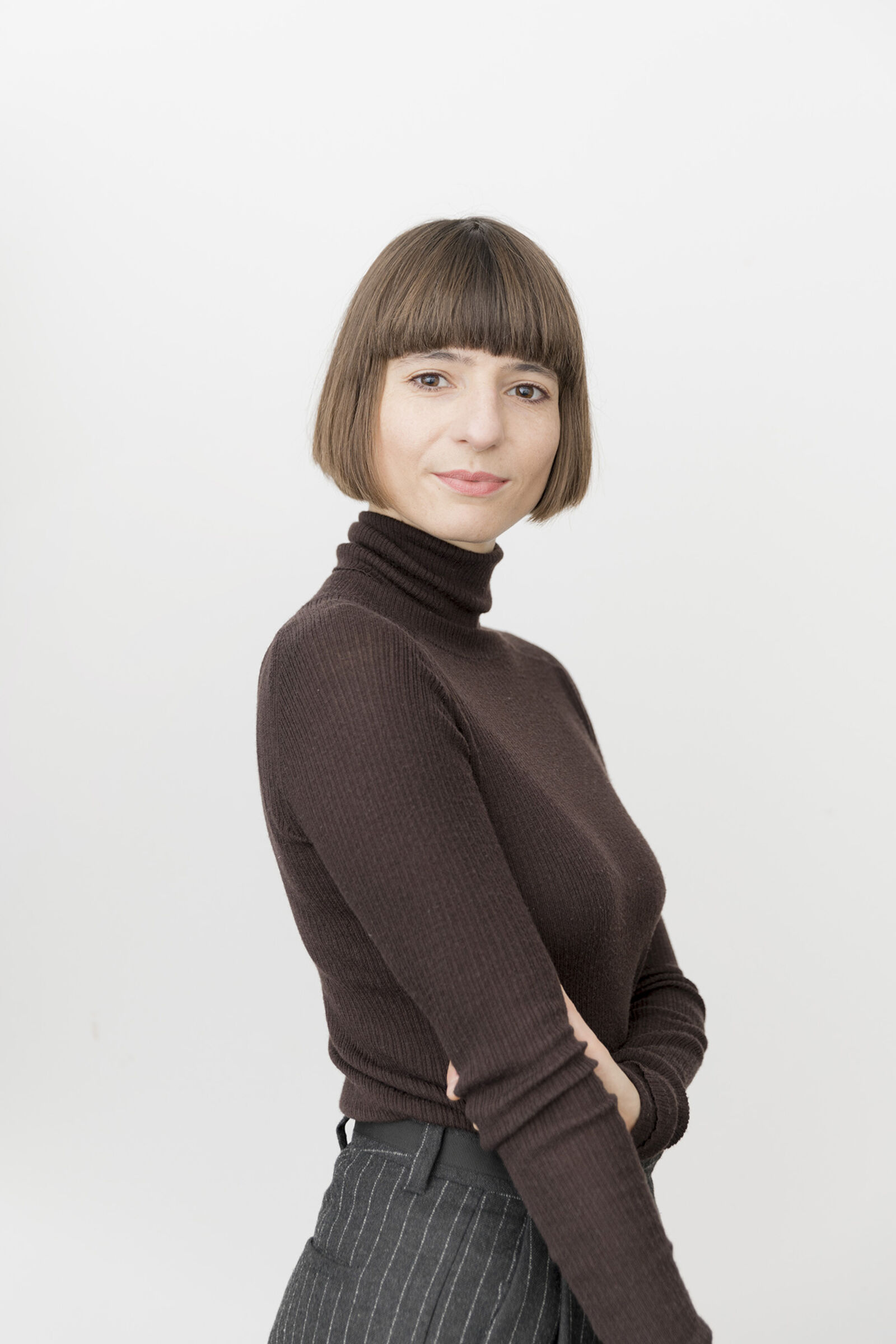











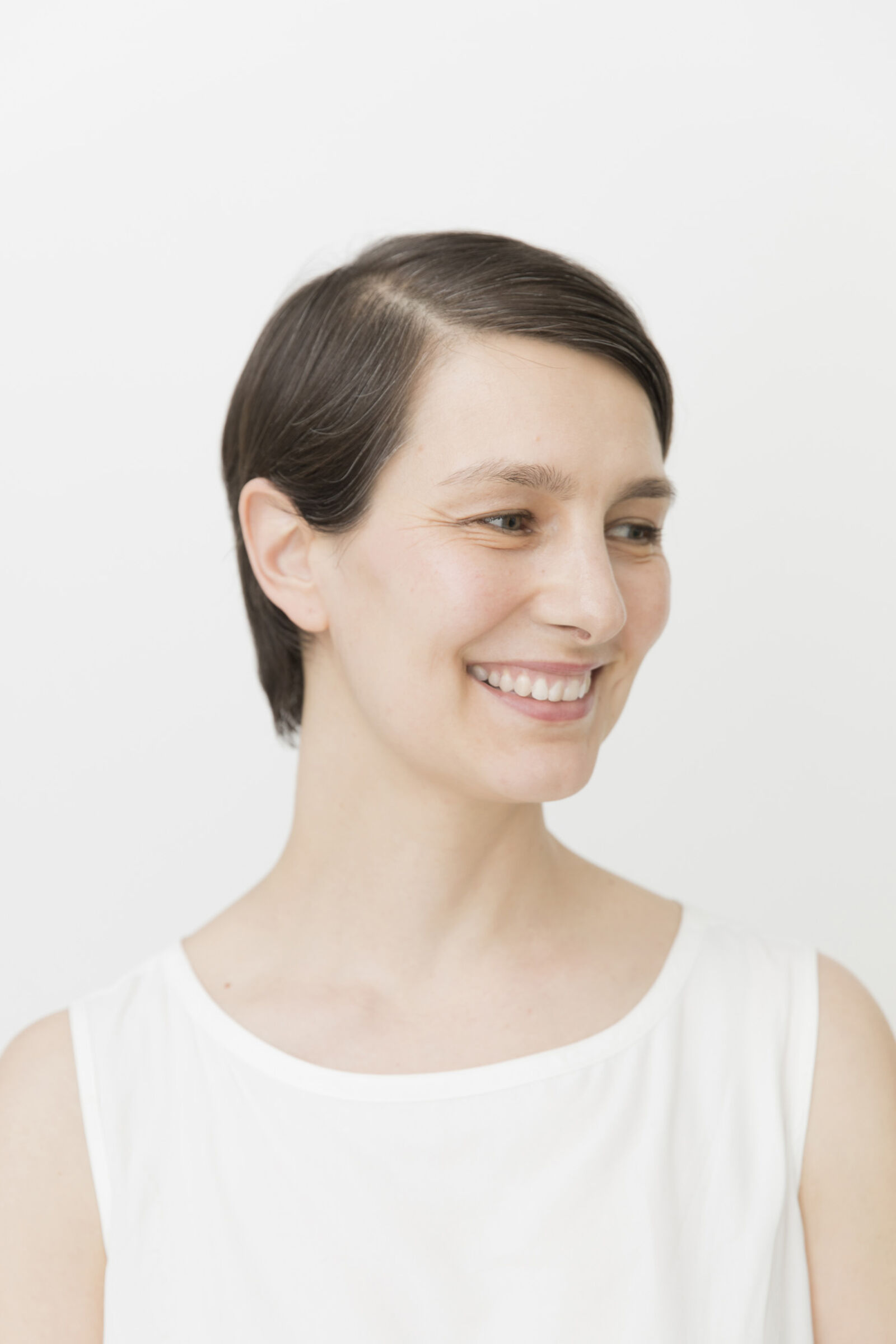


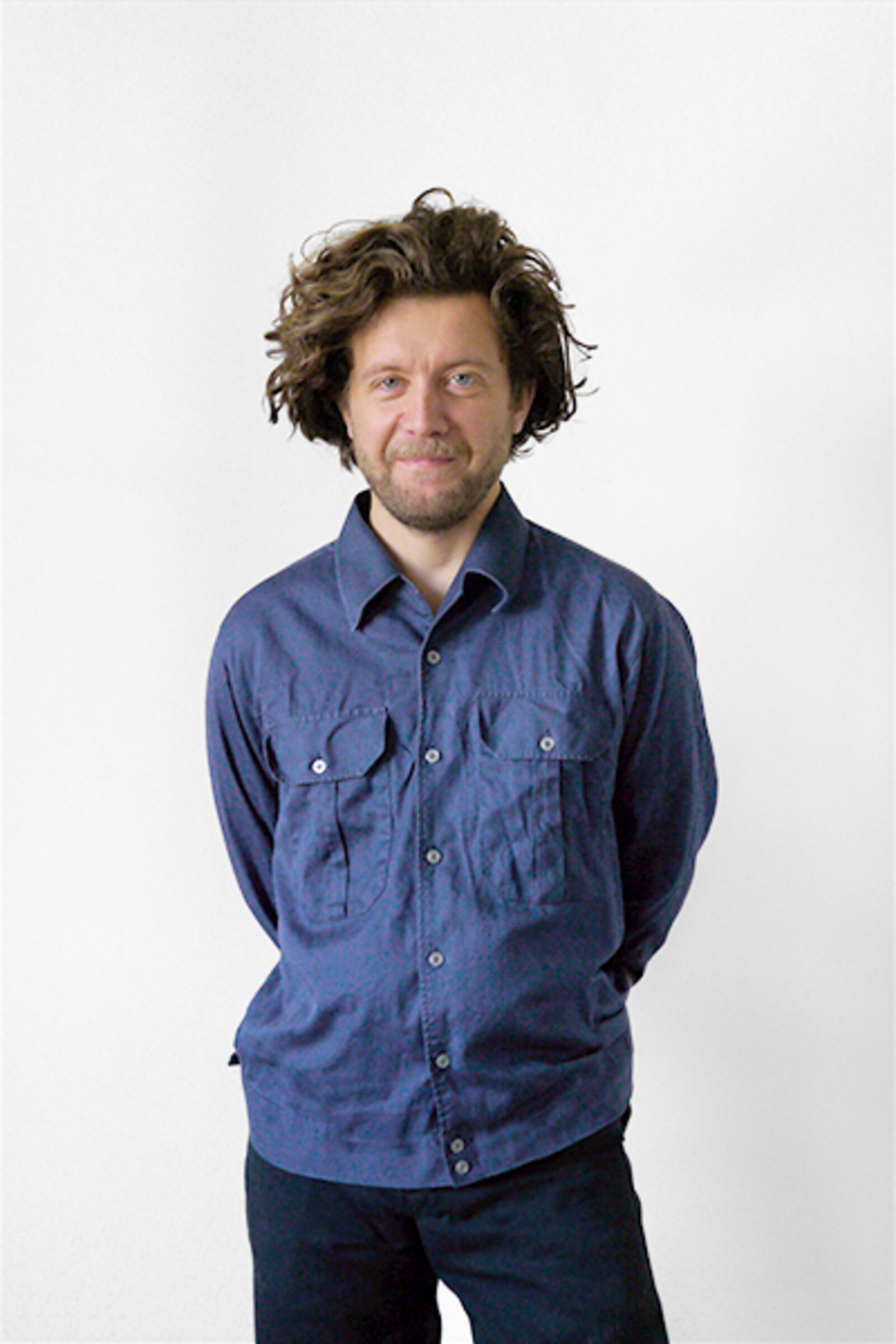










































Copyright: Staatliche Museen zu Berlin, Kunstgewerbemuseum / Gestaltung: cyan Berlin

Experimental spatial drawing and processing sedge, Embodied Architecture, 2024. Original photo by Dalma Stift and image by Elaine Bonavia. Copyright: weissensee school of art and design berlin, Matters of Activity

TRAZOS Edición Biomateriales, 2024, Gisela Pozzetti, Heidi Jalkh, Sistemas Materiales. Photo: Maia Croizet

Edward Burtinsky, Iberia Quarries #2, Marmorose EFA Co., Bencatel, Portugal, 2006

Tracing paraffin accumulations. Fieldwork on the coastline of the Curonian Spit in the Neringa Nature Reserve, Léa Perraudin and Iva Rešetar. 2024. Copyright: Iva Rešetar


Mykoplektonik by Natalija Miodragović and Dimitra Almpani-Lekka. Copyright: Matters of Activity

Beetle-infestation of spruce, Feldbuch, Frankonia. Image: Pelin Asa, MPI-CI, MoA

Book Cover Perraudin, L. 2024. Elementare Ekstasen. Sondierungen der Technosphäre. Series: Future Ecologies, Lüneburg: meson Press.

Gestalten mit Cellulose, Wasser und Luft. Copyright: Eva Bullermann

Verbautes Wetter. Copyright: Literaturforum am Brechthaus

Ausstellung »Visiting Material Futures«, Futurium 2024. Copyright: David von Becker

Poster Lecture Series 2024, Photo: Charlotte Linton. Copyright: Matters of Activity.

Project PERISKOP. Copyright: Digital Surgery Lab, Charité – Universitätsmedizin Berlin

Workshop »Critical Times. Part II: Ecologies of Relation«, April 11-13, 2024, workshop with Lara Almarcegui at ALBETON concrete plant, Rotterdam. Photo: Rahel Kesselring

Copyright: Sistemas Materiales

Multispecies Design Symposium March 2024, Kunstgewerbemuseum. Copyright: Staatliche Museen zu Berlin

»Manheim Calling«, March 2024. Foto: Rahel Kesselring

Charlett Wenig, Bark Sphere, 2021. Copyright: Alexander Magerl

Syntopia 0 – Anthropos I Human. Copyright: Roland Halbe

Cover Material Trajectories, 2023. Coypright Meson Press

»Yu Li, a diary of cooking a curtain« by Tin Qizhen Gao, detail of curtain. Copyright: Mareike Stoll for MoA Design Research Studio Beyond the Curtain

Ernest Cormier, Thermometer. ARCH252051 Ernest Cormier fonds, CCA. Copyright: Fonds Ernest Cormier, CCA

Poster Symposium »Terra Morphosis II: Patterns«

Visual Master Architecture and Urban Design Thesis Review. Copyright: Leibniz University.

MidJourney generated AI images for the prompts »architectured material across scales«, »topological interlocking«, »elastic instabilities« by Charlett Wenig | Poster Design: Node Berlin Oslo

Copyright: Rasa Weber

The struggle for the best ideas is also a social survival strategy, believes the design researcher Claudia Mareis. Her ideas are changing how we view design. | Image: Kostas Maros / 13Photo. Copyright: Horizons

Seed Coats. Copyright: Michaela Eder

Workshop participants discussing T.J. Demos recent book »Against the Anthropocene: Visual Culture and Environment Today« with the author. »Critical Times« at »Matters of Activity«, 17 & 18 November 2023

Copyright: Jann Mausen

Syntopia 1:Soma I Body. Roland Halbe

Open Space Event, 9 November 2023. Copyright: Matters of Activity

Samples of Flax Fiber Bundles as a precursor for Architectural Yarns, adapted by Node Berlin/Oslo. Copyright: Maxie Schneider, Max Planck Institute of Colloids and Interfaces, weißensee school of art and design, Matters of Activity

Film Still Building (with) Nature, 2023. Copyright: Michaela Büsse.

Copyright: Photo by My Walking Diary from Pexels

Interview mit Martin Müller, Tagesspiegel, 22. Oktober 2023. Copyright: Tagesspiegel

Gosia Lehmann, Breathless Choir. Copyright: CollActive Materials, Foto: Michelle Mantel

Exhibition Opening »Airbound«, 19 October 2023. Copyright: Matters of Activity

Still from Film »Fordland Malaise«. Copyright: Susana de Sousa Dias

Leben machen. Die Zoëpolitik der synthetischen Biologie. Copyright: DeGruyter


Floating University. Copyright: Lena Giovanazzi, Raumlabor

Copyright: Michelle Mantel, Matters of Activity

Cover »Théories du Design« at Presses du Réel

Design, Gestaltung, Formatività. Philosophies of Making. Copyright: Birkhäuser, 2022

Toxic Legacies. Copyright: Leila Wallisser

Syntopia 1—Soma I Body. Copyright: Karola Dierichs, Max Planck Institute of Colloids and Interfaces, weissensee academy of art and design and Matters of Activity

Landscape at Maralinga site (South Australia). Copyright: Wayne England, CC BY 2.0 <https://creativecommons.org/licenses/by/2.0>, via Wikimedia Commons

Workshop »Aerial Witness/ing«. Copyright: The Future of Life School, Clemens Winkler

Syntopia. Copyright: Jihae Lee, weißensee school of art and design berlin

Bark by Johanna Hehemeyer-Cürten and Willow Plektonik by »Structural Textile Project« of Natalija Miodragović, Nelli Singer and Daniel Suárez. Copyright: Johanna Hehemeyer-Cürten

Brochures, doctoral presentations 2023. Layout: Ada Favaron. Project coordination: Franziska Wegener

ICD Aggregate Pavilion 2018. Copyright: Institute for Computational Design and Construction (ICD), University of Stuttgart

As part of the performance »Tender Absence«, Siegfried Saerberg sits on a bench amidst deforested trees. Copyright: Disabled Landscapes
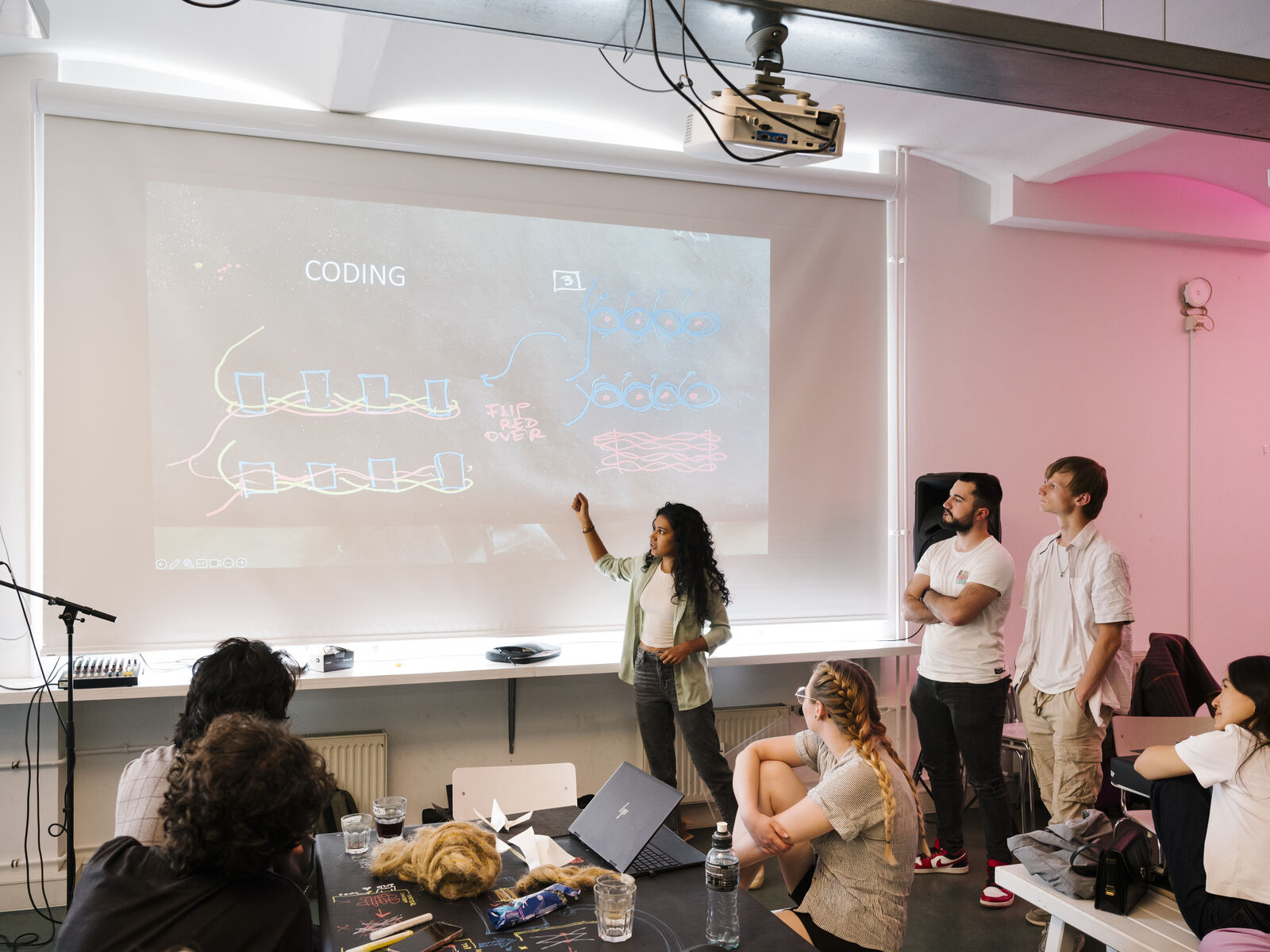
»Textile Gestures - Mapping Tactile Practices with Architectural Yarns«, Hand-on Workshop at Bauhaus Study Rooms. Copyright: Thomas Meyer

Copyright: Mina Mahouti

Poster Lecture Series, May–June 2023. Copyright: weißensee school of art and design berlin

Design of soft robots. Research on form, its deformation and possible function. Copyright: Anna Schaeffner

FiBB 2023. Copyright: Matters of Activity

Keyvisual Exhibition »Zur Nachahmung empfohlen«, Berlin, Uferhallen Wedding May to June 2023. Copyright: Jennifer Allora und Guillermo Calzadilla, from »Under Discussion«, 2004/2005, courtesy the artists, adapted by anschlaege.de

Driving the Human Book Launch at Matters of Activity, 10 May 2023. Copyright: Camille Blake / Driving the Human

Copyright: Mina Mahouti

Research Stay at Sitterwerk, St. Gallen, March 2023. Copyright: Iva Rešetar
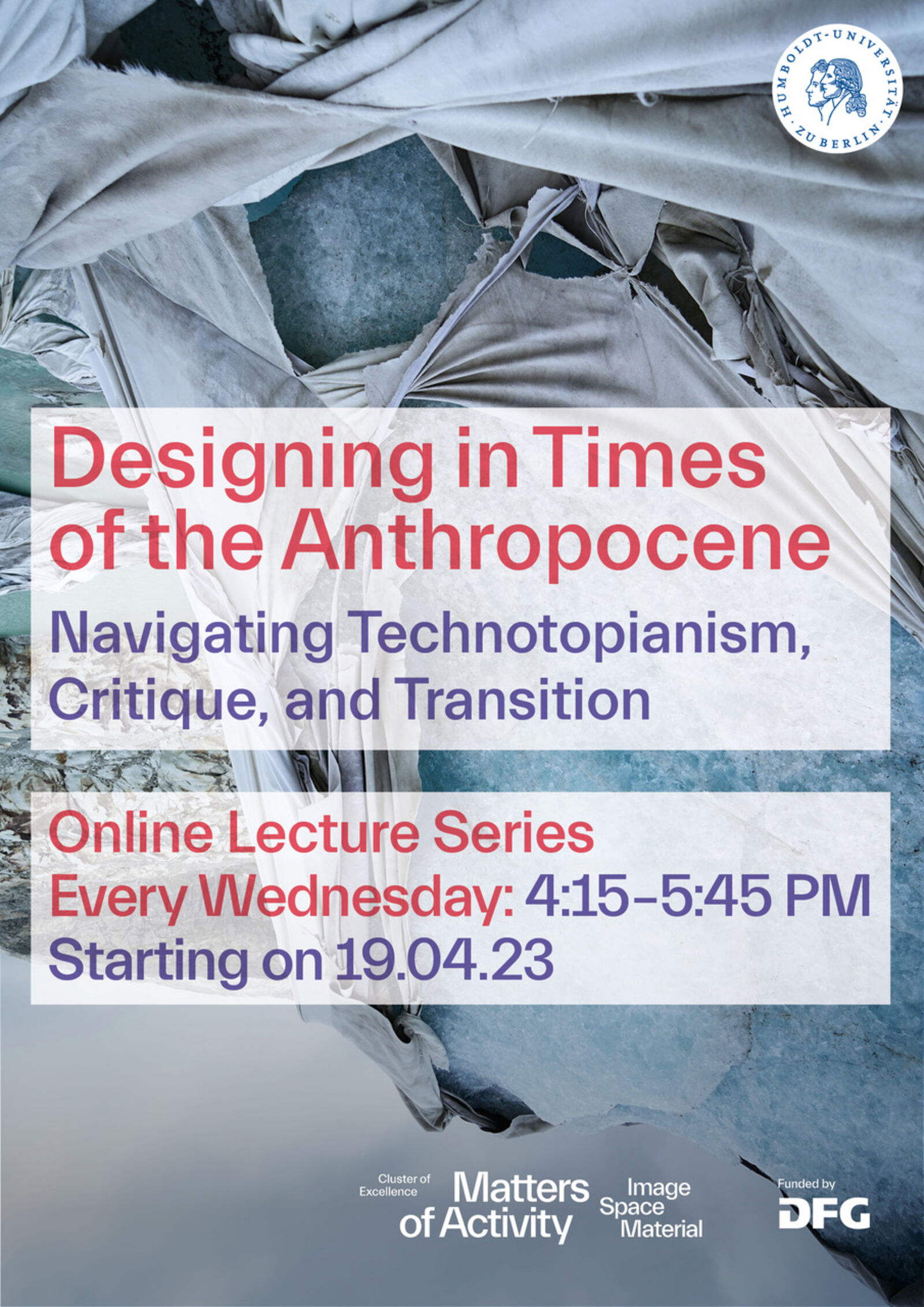
Poster Lecture Series »Designing in Times of the Anthropocene«, 2023. Copyright: Matters of Activity

Copyright: N Scot Unsplash

Chemical Reviews, Special Edition »Sustainable Materials«, Design: Ella Marushchenko, 2023. Copyright: Chemical Reviews

Petrification, publication at .able Journal, 2023. Copyright: Emile De Visscher, Ophélie Maurus

.able Journal, Going with the Flow, 2023, Image: Gisèle Trudel. Copyright: .able

»The Bark Project«, Charlett Wenig. Copyright: Patrick Walter, MPIKG

Round Table »On Fibres amd Mixtures«. Foto: Michelle Mantel. Design: studioeins, adapted by »Matters of Activity«

Design: studioeins, adapted by MoA. Photo: Michelle Mantel

Round Table »Poetics and Politics of Sand«. Design: studioeins, adapted by Matters of Activity

MoA Diagram: Workshop Research Modules for the Creation, Cognition and Perception of Matter. Copyright: Franziska Wegener

Schematic representation of the pressing process, right: ready pressed bark panels. Copyright: cc-by 4.0 PLOS ONE

Round Table »Rinde: Gestaltung mit Resten«. Design: studioeins, adapted by Matters of Activity

Flyer Book Launch, 19 January 2023. Copyright: Pro qm

Roundtable »Vascularization«. Design: studioeins, adapted by MoA

Round Table »Tesselated Material Systems«. Design: studioeins, adapted by Matters of Activity

Self-Shaping Textiles. Design: studioeins

Annual Conference »Deep Material Futures« at silent green, November 2022. Copyright: Michelle Mantel

Presenting the Humboldt Award to Heidi Jalkh. Photo: Phil Dera. Copyright: Humboldt-Universität zu Berlin

Poster Material Legacies. Image: Dietrich Polenz and the Experimental Surgery Lab, 2020

»Dissect« Event at Tieranatomisches Theater Berlin, 02.11.2022. Foto: Alexandra Ruppert. Copyright: Matters of Activity

Dissect event, »Behavioral Matter« symposium, 29/03/2019 © Centre Georges Pompidou (Paris)

Poster »Frictioned Functionality«. Copyright: Matters of Activity

Panel »Interdeterminacy and Liveliness« at MoA Annual Conference »Tipping Points« 2021. Copyright: Matters of Activity

Poster PhD presentations 2022. Layout: Ada Favaron

Poster »The Interdisciplinary World of Tangling«. Copyright: Myfwany Evans


MoA Project »Bacterial Cellulose: Co-Weaving Biofilms« at the Milano Triennale 2022. Copyright: Triennale Milano – photo by DSL Studio

Poster Online Lecture Series »Talking Matters«, Copyright: Cécile Bidan and Salif Sawadogo, adapted by NODE Berlin

Screenshot Conference Website. Copyright: Fraunhofer

Flyer Open House 2022. Copyright: weißensee school of art and design berlin.

Multiscale architectures. Left: the wooden tower of Lake Mjøsa, Norway Reproduced with permission from [1]. Copyright: Voll Arkitekter AS & Ricardo Foto. Right: the internal structure of wood based on parallel tube-like wood cells with diameters in the range of tens of microns (shown for several wood species from top to bottom). The white arrow points to a sketch where nanometer-thick cellulose fibrils are indicated by black lines [2] John Wiley & Sons. Copyright: 2020 The Authors. Published by Wiley-VCH GmbH

Nursery stock of spruce (2+0) for afforestation. Credits: wikimedia commons / adapted by Matters of Activity

Minimal Machines 2 – Hygroscopic Hemp. Copyright: Nuri Kang / weißensee school of art and design berlin, Image: Karola Dierichs / weißensee school of art and design berlin, Matters of Activity.

Collection Overview - Tessellation Archive. Copyright: Felix Rasehorn

The Pergola at Rundgang Weißensee School of Art and Design Berlin. Copyright: Maxie Schneider/ Matters of Activity

Poster »On Gestaltung«. Copyright: weißensee school of art and design berlin

Dis/Entangling Material Futures. Copyright: Claudia Mareis

Collagen fiber bundle after mineralization with bone mineral calcium phosphate under an electron microscope. Copyright: Max Planck Institute of Colloids and Interfaces

Cover of the publication »Atem/Breath. Gestalterische, ökologische und soziale Dimensionen/ Morphological, Ecological and Social Dimensions«, edited by Linn Burchert and Iva Rešetar.

Poster New European Bauhaus Conference 2022

Copyright: Michelle Mantel, Matters of Activity

Designing Matter 2. Copyright: Clara Poeverlein / weißensee school of art and design berlin

Material Geometry — Intersecting Cones I. Copyright: Karola Dierichs and Katharina Lindenberg; Institute for Computational Design and Construction, University of Stuttgart; Städelschule Architecture Class; 2013

Tipping Points. Copyright: Josef Luis Pelz & NODE Berlin Oslo
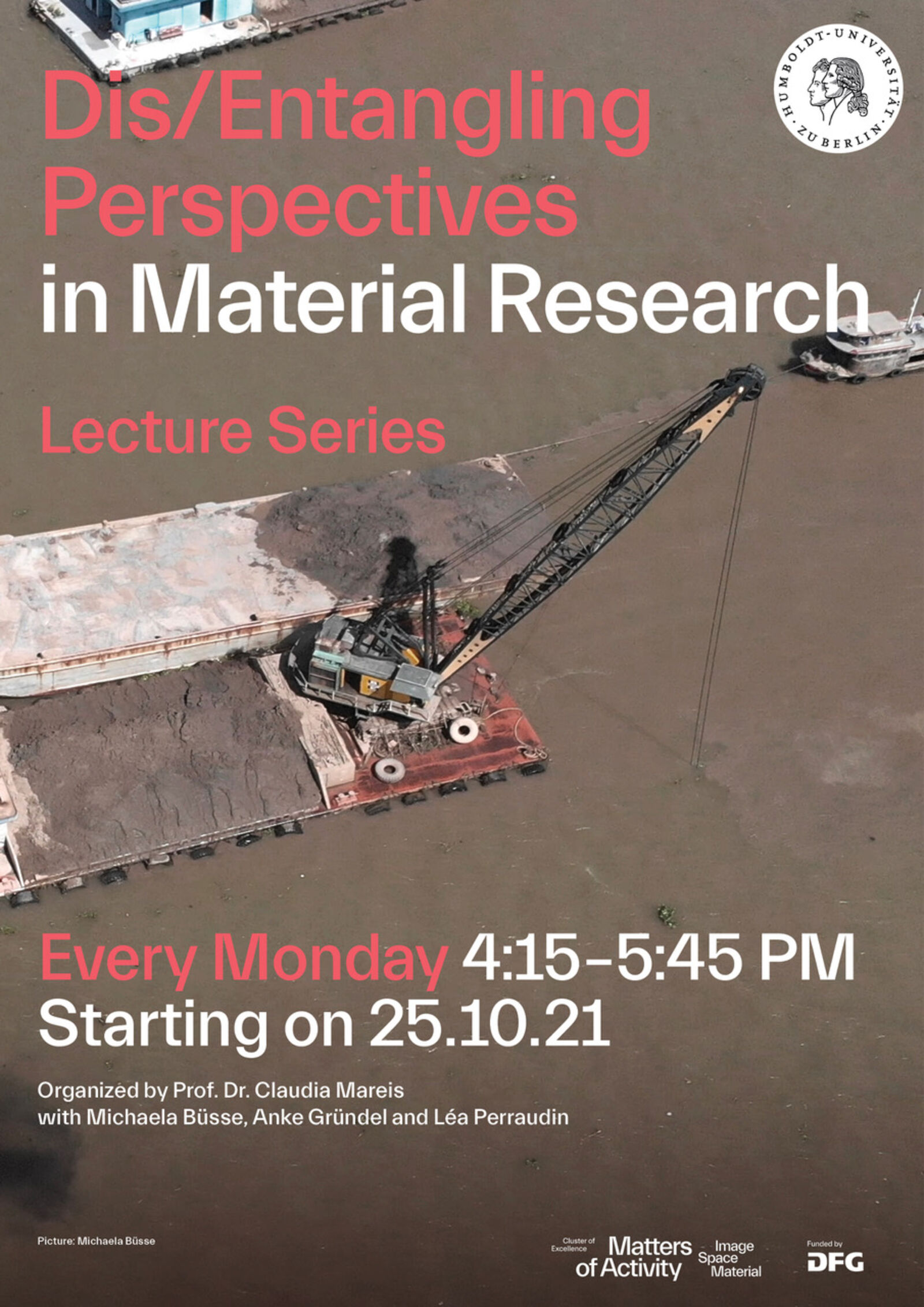
Poster »Dis/Entangling Perspectives in Material Research«. Copyright: Matters of Activity | Image: Michaela Büsse

Copyright: Leila Wallisser / weißensee school of art and design berlin
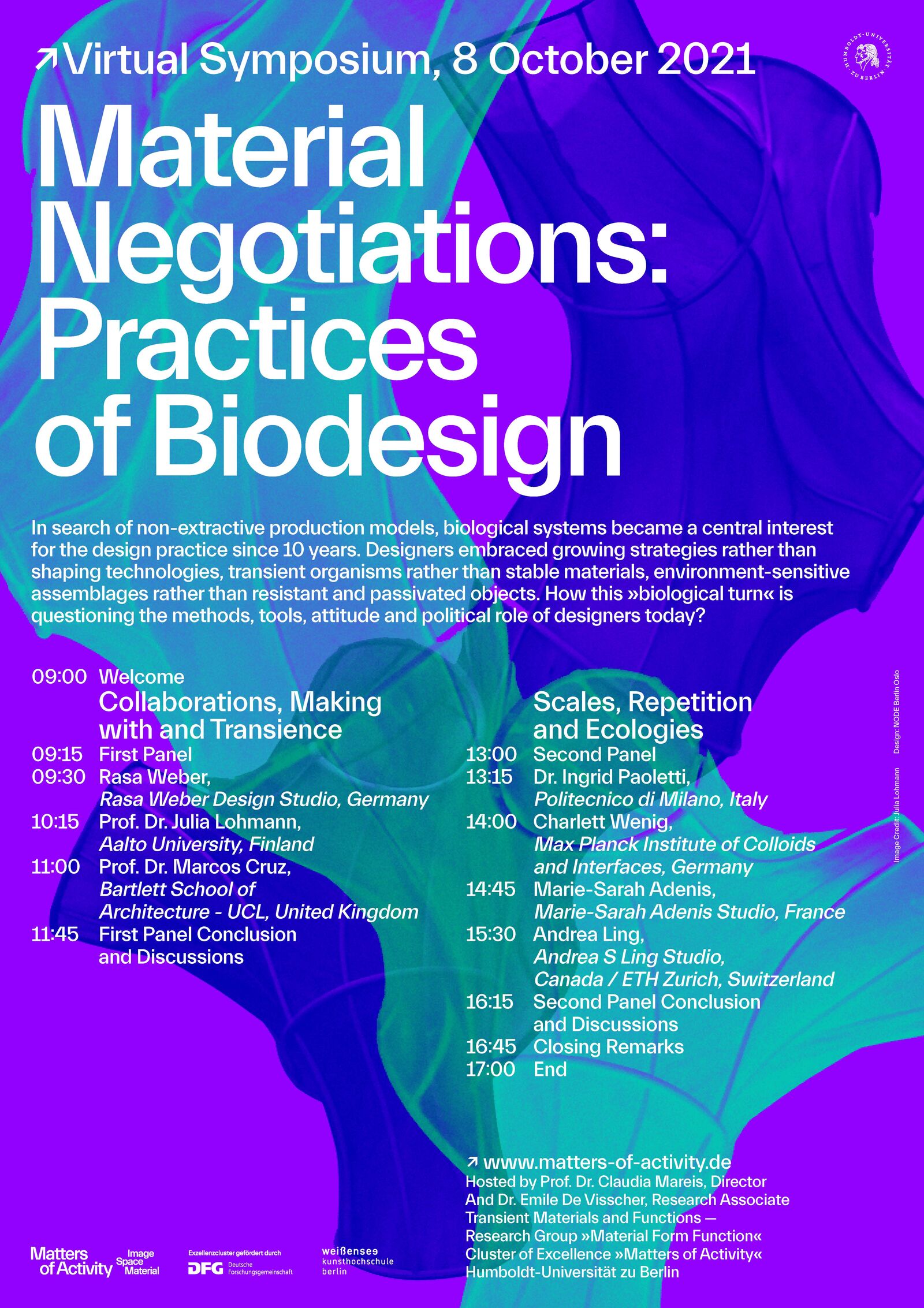
Poster virtual symposium »Material Negotiations«. Copyright: Julia Lohmann, adapted by NODE Berlin

Prix Liliane Bettencourt pour l’intelligence de la main® 2021, Jury Members and Laureates. Copyright: Olaf Avenati

Visual Recording Forum Wissenschaftskommunikation 2021. Copyright: Lorna Schütte for »Wissenschaft im Dialog«
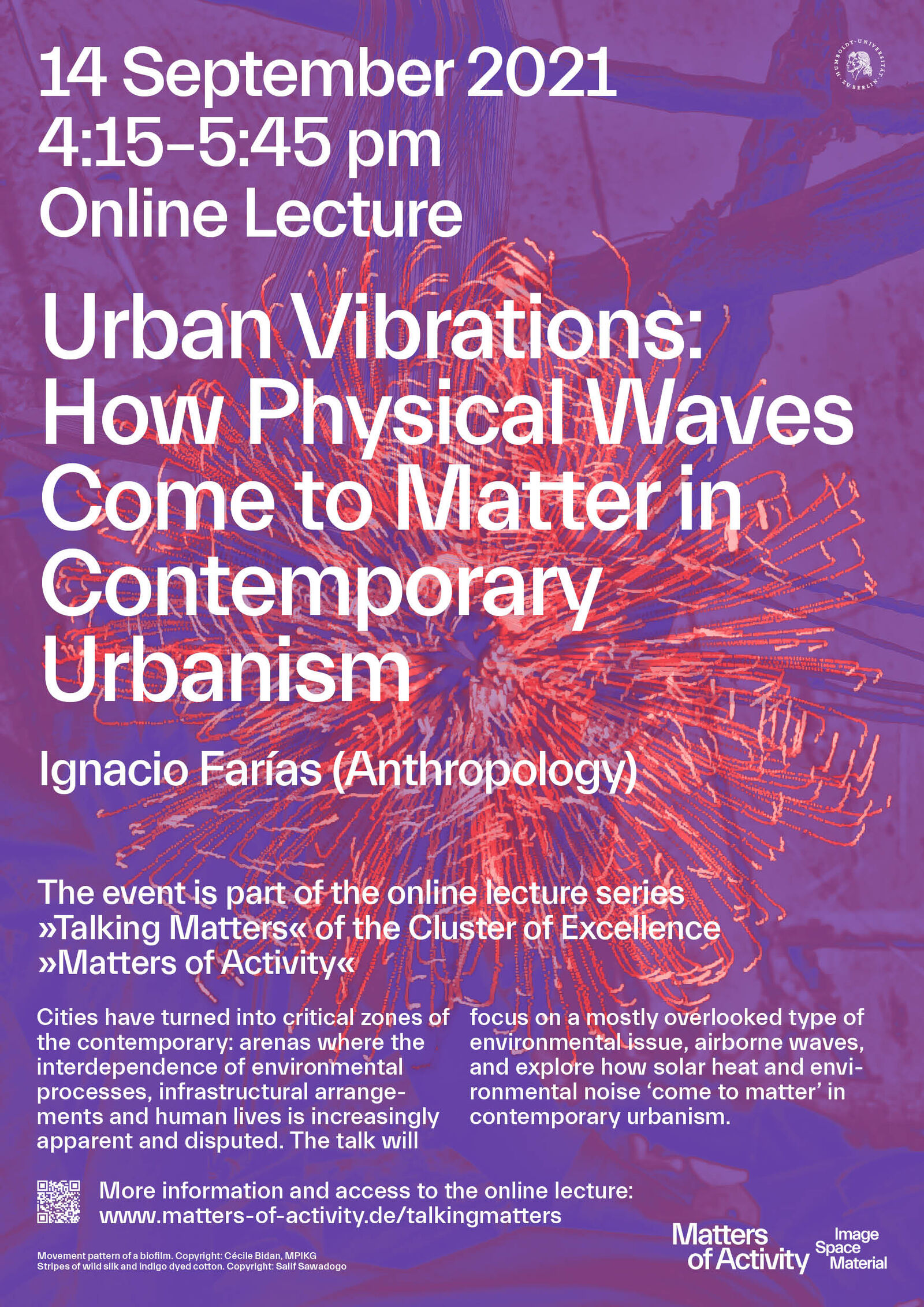
Poster Online Lecture Series »Talking Matters«, Copyright: Cécile Bidan and Salif Sawadogo, adapted by NODE Berlin

Teaserpicture DRHR2021. Copyright: Ravi Kumar / Unsplash.

Copyright: Elaine Bonavia & Elisa Martignoni, weißensee school of art and design berlin, 2021

Scaling Fiber: Experimental Yarn. Copyright: weißensee school of art and design berlin

Banner »Times of Waste«. Copyright: Rory Witt

Scaling Nature (1): Wrinkles«: Liquid Lacquer. Copyright: weißensee school of art and design berlin / Luis Magg | Bacterial cellulose curtain. Copyright: Bastian Beyer and Iva Rešetar

Website DRHA Digital Matters. Copyright: Lucius Fekonja

Poster Online Lecture Series »Talking Matters«, Copyright: Lucius Fekonja, Bastian Beyer, Iva Rešetar, adapted by NODE Berlin

Poster Online Lecture Series »Talking Matters«, Copyright: Cécile Bidan and Salif Sawadogo, adapted by NODE Berlin

Circular processes and feedback loops in additive manufacturing processes, Babette Wiezorek 2016, porcelain, 3D printing (detail). Copyright: Babette Wiezorek 2016.

»Material Trajectories. Designing with Care« Annual Conference of the Annual Conference of the German Society for Design Theory and Research (DGTF). Copyright: DGTF

All 7 Berlin Clusters of Excellence are represented with a film at the foyer at Humboldt Lab. Copyright: Matters of Activity, Humboldt-Universität zu Berlin

Situated Digital Agencies. Copyright: Maxie Schneider

Biological materials are built with a limited number of building blocks, based on polysaccharides, proteins, and minerals. Copyright: Julia Blumenthal

Magic Circle Symposium weissensee school of art and design berlin, »Erosive Modeling«. Copyright: Kristin Dolz.

Copyright: Felix Noak, ExC Science of Intelligence

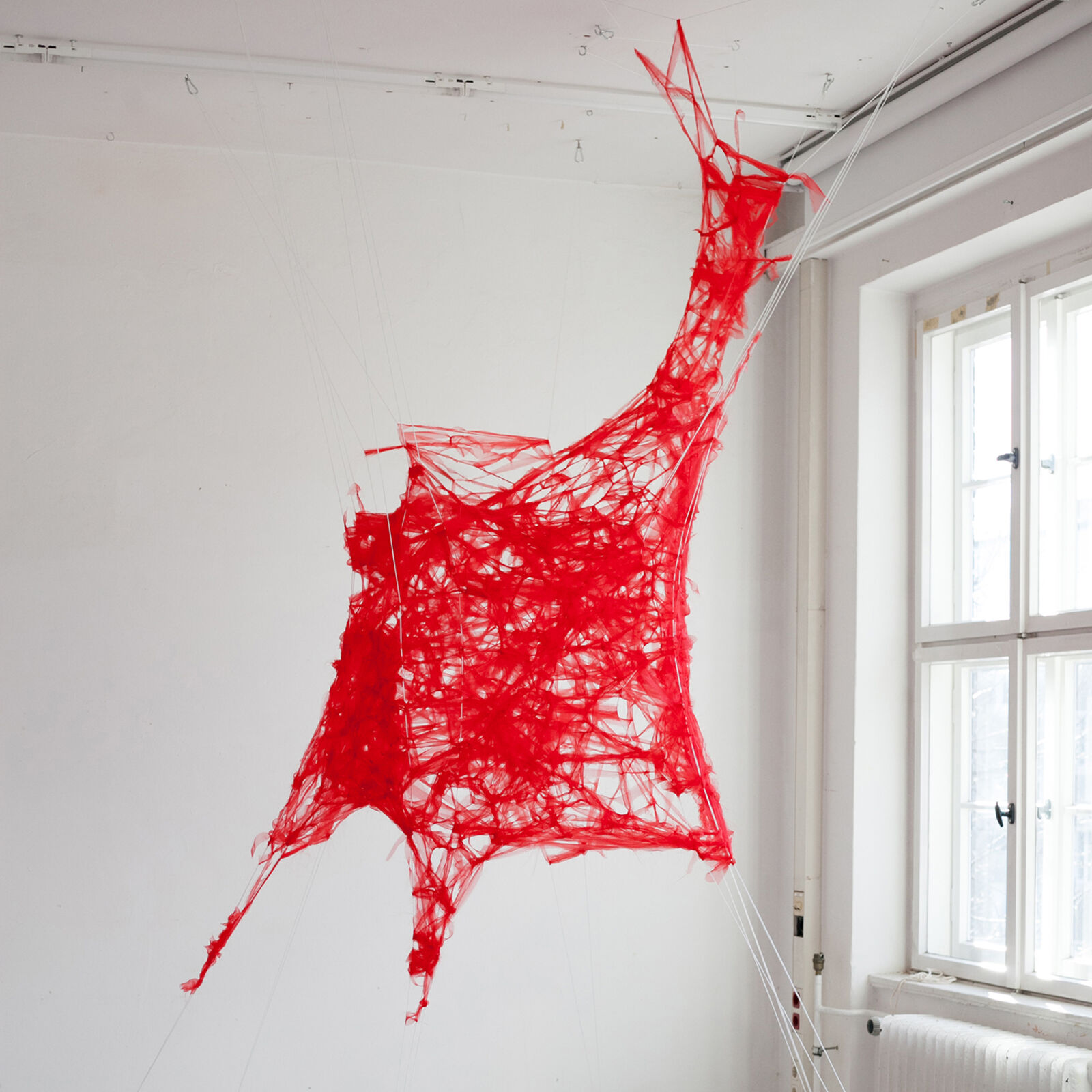
Project: Lara Rocho, weißensee school of art and design berlin. Copyright: Dr. Mareike Stoll

Poster Shelf Live. Copyright: Matters of Activity

Key Visual MoA Annual Conference. Copyright: Matters of Activity

Hypertopia. Copyright: State Studio

Copyright: https://www.sciencedirect.com/science/article/pii/S1742706120305365?dgcid=author

Conference »Coworking Materials«: Sophia Höretzeder, Chemical Aesthetics, 2020. Sophia Höretzeder is a B.A. graduate of Fashion & Technology Studies at Kunstuniversität Linz. Copyright: Sophia Höretzeder, Kunstuniversität Linz

Biomaterials, Vol. 257, October 2020. Copyright: Elsevier

»The Bark Project«, Charlett Wenig. Copyright: Patrick Walter, MPIKG

Yin 阴 , Cindy Peng. Copyright: weißensee school of art and design berlin, Cindy Peng

Poster Workshop »Material as Environmental Device«. Copyright: Kristina Pfeifer »detail woven skin of Kurdish black tent« & Cécile Bidan »detail of bacterial cellulose biofilm«

»Wir sind Humboldt«. Image brochure of Humboldt-Universität zu Berlin. Fotos: Matthias Heyde, Grafic Design: Weserloh Media. Copyright: Humboldt-Universität zu Berlin

Hybrid Interactions for Neurosurgical Planning. Project Digital Twin. Copyright: Felix Rasehorn

»Scaling Nature (2): Fibers, Muscles and Bones« Final Presentation. Copyright: weissensee academy of art berlin

Design Studio »Scaling Nature (1): Wrinkels«, Design: Juni Neyenhuys and Stefanie Eichler. Copyright: weißensee kunsthochschule berlin

Stone Web – Spatial module system made from basalt fibre at the weissensee academy of art berlin (Idalene Rapp, Natascha-Katharina Unger, Christiane Sauer). Copyright: weissensee academy of art berlin, I. Rapp, N. Unger

Copyright: Institute of Network Cultures

Copyright: Jonas Lauströer, Amir Andikfar, John Nyakatura (HU Berlin)

Cacao Cloud by Clemens Winkler. Copyright: Michelle Mantel

Clemens Winkler is presenting his »Wolkenkammer« during the project presentation of »Object Space Agency«. Copyright: Franziska Wegener.


Workshop Behavioral Matter. Copyright: Patricia Ribault

Bacterial cellulose curtain. Experiments: Bastian Beyer and Iva Rešetar (design), Skander Hathroubi (microbiology). Photo: Bastian Beyer, adapted by Ada Favaron. Project coordination: Elisabeth Obermeier & Franziska Wegener
Perraudin, L. 2024. Elementare Ekstasen. Sondierungen der Technosphäre. Series: Future Ecologies, Lüneburg: meson Press.
Mareis, C. 2023. Théories du design – Une introduction. Preface by Claire Brunet and Emanuele Quinz. Postface by Guy Julier. Translated from the German by Maxime Le Calvé. Trans. of Theorien des Designs zur Einführung. Dijon: Les presses du réel.
Müller, M. 2023. Leben machen. Die Zoëpolitik der synthetischen Biologie. Berlin, Boston: De Gruyter.
https://doi.org/10.1515/9783111004105
Mareis, C., Rottmann, M. 2020. Entwerfen mit System. Studienhefte Problemorientiertes Design, 10, Hamburg: Adocs.
Quinz, E. 2020. Contro l’oggetto. Conversazioni sul design. Macerata: Quodlibet.
Bauer, F., Kim, Y., Marienberg, S., Schäffner, W. eds. 2024. Toward a New Culture of the Material. Berlin: De Gruyter.
https://doi.org/10.1515/ 9783110714883
Perraudin, L., Winkler, C., Mareis, C., Held, M. eds. 2023. Material Trajectories. Designing With Care? Lüneburg: meson press.
https://doi.org/10.14619/2201
Mareis, C., Greiner-Petter, M., Renner, M. eds. 2022. Critical by Design? Genealogies, Practices, Positions. Bielefeld: transcript.
https://doi.org/10.14361/9783839461044
Ribault, P. ed. 2022. Design, Gestaltung, Formatività. Philosophies of Making. Berlin, Boston: Birkhäuser.
https://doi.org/10.1515/9783035622447
Burchert, L., Rešetar, I. eds. 2021. Atem / Breath: Gestalterische, ökologische und soziale Dimensionen / Morphological, ecological and social dimensions. Proceedings of the conference »Atem (Breath)« at the Department of Art & Visual History, Humboldt-Universität zu Berlin, 11.9.2019–13.9.2019. Berlin/Boston: De Gruyter.
https://doi.org/10.1515/9783110701876
Mareis, C., Paim, N. eds. 2021. Design Struggles. Intersecting Histories, Pedagogies, and Perspectives. PLURAL, 3. Amsterdam: Valiz.
https://www.valiz.nl/images/DesignStruggles-DEF_978-94-92095-88-6single-28September22-VALIZ-def.pdf
Müller, M., Neubert, C. eds. 2021. Standardisierung und Naturalisierung. With contributions by Sprenger, F., Echterhölter, A., Mämecke, T., Wilk, N. M., Bless, R., Eichinger, T., Buckermann, P., Schreiber, A., Ribault, R., Lucci, A., Jany, S., Rieger, S. and Macho T. Schriftenreihe des Graduiertenkollegs »Automatismen«, 17. Paderborn: Wilhelm Fink.
https://doi.org/10.17619/UNIPB/1-1108
Alexandre, P., Jouannais, J., Ribault, P., Semin, D. eds. 2020. Art et Camouflage. With contributions by Alexandre, P., Ribault, P., Aubagnac, G., Semin, D., Aubry, M., Bergounioux, P., Coutin, C., Shell, H. R., Schäffner, W. and Thierrée, V. Paris: Beaux-Arts Éditions, ENSBA.
Fratzl, P., Jacobs, K., Möller, M., Scheibel, T., Sternberg, K. eds. 2019. Materials Research: Inspired by Nature. acatech Discussion. München: utzverlag.
https://www.acatech.de/publikation/materialforschung-impulsgeber-natur/
Beyer, B., Rešetar, I. 2024. »Entangled Scales: Structures and Environments of Cellulose Biofilms.« In Towards a New Culture of the Material, edited by Bauer, F., Kim, Y., Marienberg, S., Schäffner, W. forthcoming.
Hehemeyer-Cürten, J., Wenig, C. 2024. »The Bark Project.« In Trazos edición biomateriales, edited by Pozzetti, G., Jalkh, H. Buenos Aires, Argentina: Sistemas Materiales, 98.
Mareis, C. 2024. »Design und Wissenschaft.« In Handbuch Designwissenschaft: Geschichte – Theorie – Praxis, edited by Hensel, T., Ruf, O. Stuttgart: J.B. Metzler Verlag, Forthcoming.
Mareis, C. 2024. »Rubber Frictions: Material Legacies beyond the 1851 Great Exhibition.« In Toward a New Culture of the Material, edited by Bauer, F., Kim, Y., Marienberg, S., Schäffner, W. Berlin: De Gruyter, 193–222.
https://doi.org/10.1515/9783110714883-015
Perraudin, L. 2024. »Surface Tension. Venice and the Undercurrents of Mediation.« In Towards a New Culture of the Material, edited by Bauer, F., Kim, Y., Marienberg, S., Schäffner, W. Berlin: De Gruyter. Forthcoming, 173-189.
Stock, R. 2024. »Politiken der Langsamkeit. Perspektiven der kulturwissenschaftlichen Disability-Forschung und Environmental Dis-/Humanities.« In KörperZeiten. Narrative, Praktiken und Medien, edited by Wallerstein, Konstanze, Röderer, Fabian, Bolz, Manuel Schriftenreihe der Isa Lohmann-Siems Stiftung, Bd. 17. Berlin: Dietrich Reimer Verlag, 195-218.
https://doi.org/10.5771/9783496030928-195
De Visscher, E. 2023. »›Matière‹ and ›Matériau‹ - Thoughts on Two Ways to Consider Materials and their Design.« In Let’s Get Sustainable. Art, Design and Architecture, edited by Frye, A., Kruse, C., Majewski, A., Schramke, S. Wien: Verlag für Moderne Kunst, 229-239.
Hengge, R., Krauthausen, K. 2023. »The Event of a Fiber.« In Architectures of Weaving: From Fibers and Yarns to Scaffolds and Skins, edited by Sauer, C., Stoll, M., Fransén Waldhör, E., Schneider, M. Berlin: Jovis Verlag GmbH, 22-28.
Müller, M., Tikka, E. 2023. »Mammoths and Reindeer: Speculative Design Imaginaries and Technoscientific Care in the Arctic.« In Material Trajectories. Designing With Care?, edited by Perraudin, L., Winkler, C., Mareis, C., Held, M. Lüneburg: meson press, 103-122.
https://doi.org/10.14619/2201
Perraudin, L., Winkler, C. 2023. »Desinging With Care? A Pending Question.« In Material Trajectories. Designing With Care?, edited by Perraudin, L., Winkler, C., Mareis, C., Held, M. Lüneburg: meson Press, 15-29.
https://doi.org/10.14619/2201
Bauer, F. 2022. »From Renaissance Precision to Computational Uncertainty.« In Italian Imprints: Influences and Issues in Architectural Culture in the Long Twentieth Century, edited by Costanzo, D., Leach, A. London: Bloomsbury, 81-94.
Caison, G., Perraudin, L. 2022. »To Carry Water. An Invitation to Move and Sense Otherwise.« In Venice and the Anthropocene: An Ecocritical Guide, edited by Baldacci, C., Bassi, S., De Capitani, L., Omodeo, P. D. Venice: Wetlands, 161-165.
De Visscher, E. 2022. »From the Invention of Manufacturing Processes to the Discovery of Matter.« In Design, Gestaltung, Formatività. Philosophies of Making, edited by Ribault, P. Basel: Birkhäuser, 197-208.
Guiducci, L., Lepart, S. 2022. »Expansions and Imperfections. Experiments on a Self-Morphing Lattice.« In Design, Gestaltung, Formatività. Philosophies of Making, edited by Ribault, P. Basel: Birkhäuser, 343-354.
Guiducci, L. 2022. »Interweaving Disciplines - How Biological Materials Inspire New Teaching and Research Formats in Design.« In Architectures of Weaving. From Fibers and Yarns to Scaffolds and Skins, edited by Sauer, C., Stoll, M., Fransén Waldhör, E., Schneider, M. Berlin: Jovis, 74-80.
Mareis, C., Greiner-Petter, M., Renner, M. 2022. »Critical by design? An introduction.« In Critical by Design? Genealogies, Practices, Positions, edited by Mareis, C., Greiner-Petter, M., Renner, M. 8-31.
https://doi.org/10.14361/9783839461044-001
Mareis, C. 2022. »From Invisible Design to Post-Optimal Objects. Interface Design and Discourses of Dematerialization since circa 1960.« In Design, Gestaltung, Formatività. Philosophies of Making, edited by Ribault, P. Basel: Birkhäuser, 147-158.
https://doi.org/10.1515/9783035622447-011
Razghandi, K. 2022. »Rethinking Materials Paradigm: Towards an Active Understanding of Gestalt.« In Design, Gestaltung, Formatività. Philosophies of Making, edited by Ribault, P. Basel: Birkhäuser, 263-271.
Rešetar, I., Sauer, C., Schneider, M., Shone, J. 2022. »Architectural Yarns.« In Material Legacies, edited by Büsse, M., Winberg, A., Pinto, H. Berlin. 8-9.
https://www.matters-of-activity.de/de/activities/8684/design-lab-13-material-legacies
Highlighted by TAZ, Am Knotenpunkt des Materials, 15. 11. 2022, Noemi Molitor.
Rešetar, I., Sauer, C. 2022. »Architectural Yarns: Temporal Structures for Environmental Regeneration.« In Architectures of Weaving: From Fibers and Yarns to Scaffolds and Skins, edited by Sauer, C., Stoll, M., Waldhör, E. F., Schneider, M. Berlin: Jovis, 140-148.
https://doi.org/10.1515/9783868598315
Ribault, P. 2022. »Design, Gestaltung, Formatività: An Introduction.« In Design, Gestaltung, Formatività. Philosophies of Making, edited by Ribault, P. Basel: Birkhäuser.
https://doi.org/10.1515/9783035622447
Schmidt, B., Ribault, P., Petruschat, J. 2022. »Knowing, Blowing, Forming — A Conversation about Glassmaking, by Patricia Ribault and Jörg Petruschat.« In glass – hand formed matter, edited by Schmidt, B.
Wenig, C. 2022. »The Bark Project. Combining Science and Design to Elaborate New Models of Production for the Design Industry.« In Design, Gestaltung, Formatività. Philosophies of Making, edited by Ribault, P. Basel: Birkhäuser, 273-284.
https://doi.org/10.1515/9783035622447-021
Bauer, F., Skafte, L. 2021. »Persistent Modelling of the Built. A Collective Experiment Merging Structural Preservation and Digital Design Between Academia and Industry.« In Design Commons - Practices, Processes and Crossovers, edited by Bruyns, G., Kousoulas, S. London: Springer.
Burchert, L., Guiducci, L., Gruber, P., Sauer. C. 2021. »Breathing Skins. Plant Leaves and Architecture.« In Atem / Breath: Gestalterische, ökologische und soziale Dimensionen / Morphological, Ecological and Social Dimensions, edited by Burchert, L., Rešetar, I. De Gruyter, 359-379.
https://doi.org/10.1515/9783110701876
De Visscher, E. 2021. »Approcher les modes de fabrication par le design.« In MàJ, Design, environnements techniques & pratiques exploratoires, edited by Bertrand, G., Favard, M., Lartigaud, D.O. Saint-Etienne: Cité du Design, 1-8.
Gholami F., Guiducci L., Yani S., Razghandi, K. 2021. »Rethinking Active Matter.« In Active Materials, edited by Fratzl, P., Friedman, M., Krauthausen, K., Schäffner, W. Berlin: De Gruyter.
https://doi.org/10.1515/9783110562064
Müller, M. 2021. »Universale Konstrukteure? Vom αὐτός des Lebendigen zur Affirmation der synthetischen Biologie als universale Ingenieurswissenschaft.« In Standardisierung und Naturalisierung, edited by Müller, M., Neubert, C. Schriftenreihe des Graduiertenkollegs »Automatismen«, 17. Paderborn: Wilhelm Fink, 233–243.
https://doi.org/10.17619/UNIPB/1-1108
Perraudin, L., Rešetar, I., Winkler, C. 2021. »The Body of Breath: Morphologies of Air Movement.« In Atem / Breath: Gestalterische, ökologische und soziale Dimensionen / Morphological, ecological and social dimensions, edited by Burchert, L., Rešetar, I. Berlin/Boston: De Gruyter.
https://doi.org/10.1515/9783110701876-006
Perraudin, L. 2021. »Augmenting the Material Reality of Computing.« In Extended Reality – Code and Materiality in Art and Culture: Catalog, edited by Schürrer, D., Stark, M. Berlin: HTW/HU Berlin, 16-23.
https://doi.org/10.5281/zenodo.5714450
Ribault, P. 2021. »Blowing as a Mode of Giving Form. Perspectives on Two Cultural Techniques.« In Atem / Breath: Gestalterische, ökologische und soziale Dimensionen / Morphological, ecological and social dimensions, edited by Burchert, L., Resetar, I. Berlin/Boston: De Gruyter, 119-133.
Mareis, C. 2020. »Kreatives Problemlösen. Entwurfsdebatten im Kontext von Designmethodologie und Kreativitätsforschung.« In Entwerfen mit System, edited by Mareis, C., Rottmann, M. Studienhefte Problemorientiertes Design, 10. Hamburg: adocs, 25-120.
Müller, M. 2020. »Nach CRISPR. Zur dritten Proliferation der Biopolitik (1800/1943/2004).« In Milieu Fragmente. Technologische und ästhetische Perspektiven, edited by Ladewig, R., Seppi, A. Leipzig: Spector Books, 331-344.
https://spectorbooks.com/milieu-fragmente
Ribault, P. 2020. »Being Hermann August Weizenegger.« In ATMOISM: Gestaltete Atmosphären. Eine Ausstellung von Hermann August Weizenegger, Berlin Kunstgewerbemuseum, Berlin: Verlag für moderne Kunst, 184-187.
Ribault, P. 2020. »De la forme à l’informe. La stratégie du poulpe.« In Art et Camouflage, edited by Alexandre, P., Jouannais, J., Ribault, P., Semin, D. Paris: Beaux-Arts Éditions, ENSBA.
Bianchini, S. 2019. »Art & Design: poser des conditions d'expérimentation en commun.« In Design en regards, edited by Bihanic, D. Paris: Art Book Magazine.
Mareis, C. 2019. »Die Zeitlichkeit des Entwerfens. Visuelle Prozessmodelle und ihre temporale Bedeutung.« In Visuelle Zeitgestaltung, edited by Blümle, C., Mareis, C., Windgätter, C. Bildwelten des Wissens. Kunsthistorisches Jahrbuch für Bildkritik, 15. Berlin/Boston: Akademie Verlag, 114–123.
https://doi.org/10.1515/9783110565423
Rešetar, I. 2019. »Adaptive Material Systems for Thermal Comfort in Architecture Based on Phase Change Materials.« In ArcInTexETN, edited by Dumitrescu, D., Hallnäs, L., Hermansson, M., Nordlund Andersson, A., Thornquist, C. Borås, Sweden: University of Borås, 42-57.
Ribault, P. 2019. »Gestaltung, ou la dynamique des formes.« In Staatliche Bauhaus cent pour cent, 1919-2019, edited by Bihanic, D. Paris: T&P editions.
https://reflectiveinteraction.ensadlab.fr/staatliche-bauhaus-cent-pour-cent-1919-2019/
Ribault, P. 2019. »Körper bei der Arbeit. Geste, Norm und Technik.« In Standardisierung und Naturalisierung, edited by Müller, M., Neubert, C. Paderborn/München: Wilhelm Fink, 219-232.
Sauer, C. 2019. »Design mit Faserstrukturen.« In Materials Research: Inspired by Nature. acatech Discussion. acatech, edited by Fratzl, P., Jacobs, K., Möller, M., Scheibel, T., Sternberg, K.
https://www.acatech.de/publikation/materialforschung-impulsgeber-natur/
Bonavia, E., Farmer, J., Mballa-Ekobena, A., Rosenthal, N., Douny, L., Dierichs, K. 2023. »Minimal machines: augmented reality for filament-construction of partially ordered systems in architecture.« Construction Robotics.
https://doi.org/https://doi.org/10.1007/s41693-023-00109-3
Fratzl, P. 2023. »Introduction: Sustainable Materials.« Chemical Reviews, 123 (5): 1841-1842.
https://doi.org/10.1021/acs.chemrev.3c00091
Perraudin, L., Caison, G. 2023. »To Carry Water. An Invitation to Move and Sense Otherwise.« In Venice and the Anthropocene: An Ecocritical Guide, special issue. Edited by Baldacci, C., Bassi, S., De Capitani, L., Omodeo. koozArch. Un-built Imaginary.
https://koozarch.com/essays/venice-and-the-anthropocene-an-ecocritical-guide
Raguin, E., Weinkamer, R., Schmitt, C., Curcuraci, L., Fratzl, P. 2023. »Logistics of Bone Mineralization in the Chick Embryo Studied by 3D Cryo FIB-SEM Imaging.« bioRxiv, February 10: preprint.
https://doi.org/10.1101/2023.02.09.527853
Schamberger, B., Ziege, R., Anselme, K., Ben Amar, M., Bykowski, M., Castro, A. P. G., Cipitria, A., Coles, R. A., Dimova, R., Eder, M., Ehrig, S., Escudero, L. M., Evans, M. E., Fernandes, P. R., Fratzl, P., Geris, L., Gierlinger, N., Hannezo, E., Iglič, A., Kirkensgaard, J. J. K., Kollmannsberger, P., Kowalewska, Ł., Kurniawan, N. A., Papantoniou, I., Pieuchot, L., Pires, T. H. V., Renner, L. D., Sageman‐Furnas, A. O., Schröder‐Turk, G. E., Sengupta, A., Sharma, V. R., Tagua, A., Tomba, C., Trepat, X., Waters, S. L., Yeo, E. F., Roschger, A., Bidan, C. M., Dunlop, J. W. C. 2023. »Curvature in Biological Systems: Its Quantification, Emergence, and Implications across the Scales.« Advanced Materials, 35: 2206110.
https://doi.org/10.1002/adma.202206110
Wenig, C., Reppe, F., Horbelt, N., Spener, J., Berendt, F., Cremer, T., Frey, M., Burgert, I., Eder, M. 2023. »Adhesives free bark panels: An alternative application for a waste material.« PLOS ONE, 18 (1): e0280721.
https://doi.org/10.1371/journal.pone.0280721
Eigen, L., Baum, D., Dean, M. N., Werner, D., Wölfer, J., Nyakatura, J. A. 2022. »Ontogeny of a tessellated surface: Carapace growth of the longhorn cowfish Lactoria cornuta.« Journal of Anatomy, 241 (3): 565-580.
https://doi.org/10.1111/joa.13692
Felsenstein, M., Lindhammer, F., Feist, M., Hillebrandt, K. H., Timmermann, L., Benzing, C., Globke, B., Zocholl, D., Hu, M., Fehrenbach, U., Sinn, B. V., Pelzer, U., Sauer, I. M., Pratschke, J., Malinka, T. 2022. »Perineural Invasion in Pancreatic Ductal Adenocarcinoma (PDAC): A Saboteur of Curative Intended Therapies?« Journal of Clinical Medicine, 11 (9): 2367.
https://doi.org/10.3390/jcm11092367
Fratzl, P., Fischer, F. D., Zickler, G. A., Dunlop, J. W. C. 2022. »On shape forming by contractile filaments in the surface of growing tissues.« PNAS Nexus, 2 (1)
https://doi.org/10.1093/pnasnexus/pgac292
Fratzl, P., Sauer, C., Razghandi, K. 2022. »Editorial for the special issue: bioinspired architectural and architected materials.« Bioinspiration & Biomimetics, 17: 040401.
https://doi.org/10.1088/1748-3190/ac6646
Guiducci, L., Kycia, A., Sauer, C., Fratzl, P. 2022. »Self-organized rod undulations on pre-stretched textiles.« Bioinspiration & Biomimetics, 17: 036007.
https://doi.org/10.1088/1748-3190/ac5b85
Pavicevic, S., Reichelt, S., Uluk, D., Lurje, I., Engelmann, C., Modest, D. P., Pelzer, U., Krenzien, F., Raschzok, N., Benzing, C., Sauer, I. M., Stintzing, S., Tacke, F., Schöning, W., Schmelzle, M., Pratschke, J., Lurje, G. 2022. »Prognostic and Predictive Molecular Markers in Cholangiocarcinoma.« Cancers, 14 (4): 1026.
https://doi.org/10.3390/cancers14041026
Ping, H., Wagermaier, W., Horbelt, N., Scoppola, E., Li, C., Werner, P., Fu, Z., Fratzl, P. 2022. »Mineralization generates megapascal contractile stresses in collagen fibrils.« Science, 376 (6589): 188-192.
https://doi.org/10.1126/science.abm2664
Siri, M., Celej, M. S., Fratzl, P., Bidan, C. 2022. »Understanding biofilm physical and chemical properties at the molecular level.« Biophysical Journal, 121 (3): 181a.
https://doi.org/10.1016/j.bpj.2021.11.1830
Snellings, J., Keshi, E., Tang, P., Daneshgar, A., Willma, E. C., Haderer, L., Klein, O., Krenzien, F., Malinka, T., Asbach, P., Pratschke, J., Sauer, I. M., Braun, J., Sack, I., Hillebrandt, K. 2022. »Solid fraction determines stiffness and viscosity in decellularized pancreatic tissues.« Biomaterials Advances, 139: 212999.
https://doi.org/10.1016/j.bioadv.2022.212999
Stock, R. 2022. »Broken elevators, temporalities of breakdown, and open data: how wheelchair mobility, social media activism and situated knowledge negotiate public transport systems.« Mobilities, 18 (1): 132-147.
https://doi.org/10.1080/17450101.2022.2057810
Ayoubi, M., Tol, A. F., Weinkamer, R., Roschger, P., Brugger, P. C., Berzlanovich, A., Bertinetti, L., Roschger, A., Fratzl, P. 2021. »3D Interrelationship between Osteocyte Network and Forming Mineral during Human Bone Remodeling.« Advanced Healthcare Materials. 2100113.
https://doi.org/10.1002/adhm.202100113
Bauer, F. 2021. »On Pristine Boxes and Primeval Huts.« Drawing Matter.
https://drawingmatter.org/on-pristine-boxes-and-primeval-huts
Bauer, F. 2021. »On the Visual Agency of Manufacturing Models.« In Medios Digitales y Arquitectura, special issue. Bitacora, 46: 130 - 139.
Dierichs, K., Menges, A. 2021. »Designing architectural materials: from granular form to functional granular material.« Bioinspiration & Biomimetics, 16 (6): 065010.
https://doi.org/10.1088/1748-3190/ac2987
Estrin, Y., Beygelzimer, Y., Kulagin, R., Gumbsch, P., Fratzl, P., Zhu, Y., Hahn, H. 2021. »Architecturing materials at mesoscale: some current trends.« Materials Research Letters, 9 (10): 399-421.
https://doi.org/10.1080/21663831.2021.1961908
Gutierrez, F., Razghandi, K. 2021. »MotorSkins—a bio-inspired design approach towards an interactive soft-robotic exosuit.« In Special Issue on »Living Machines: From Biological Role Models to Soft Machines«, special issue. Bioinspiration & Biomimetics, 16 (6): 066013.
https://doi.org/10.1088/1748-3190/ac2785
Keshi, E., Tang, P., Weinhart, M., Everwien, H., Moosburner, S., Seiffert, N., Lommel, M., Kertzscher, U., Globke, B., Reutzel-Selke, A., Strücker, B., Pratschke, J., Sauer, I. M., Haep, N., Hillebrandt, K. H. 2021. »Surface modification of decellularized bovine carotid arteries with human vascular cells significantly reduces their thrombogenicity.« Journal of Biological Engineering, 15 (1)
https://doi.org/10.1186/s13036-021-00277-2
Oster, M., Dias, M. A., de Wolff, T., Evans, M. E. 2021. »Reentrant tensegrity: A three-periodic, chiral, tensegrity structure that is auxetic.« Science Advances, 7 (50)
https://doi.org/10.1126/sciadv.abj6737
Politi, Y., Bertinetti, L., Fratzl, P., Barth, F. G. 2021. »The spider cuticle: a remarkable material toolbox for functional diversity.« Philosophical Transactions of the Royal Society A: Mathematical, Physical and Engineering Sciences, 379 (2206): 20200332.
https://doi.org/10.1098/rsta.2020.0332
Razghandi, K., Janßen, N., Le, M. V., Stach, T. 2021. »The filter‐house of the larvacean Oikopleura dioica. A complex extracellular architecture: From fiber production to rudimentary state to inflated house.« Journal of Morphology, 282 (8): 1259-1273.
https://doi.org/https://doi.org/10.1002/jmor.21382
Rešetar, I., Jurtz, N., Böhm, L., Kraume, M., Palz, N. 2021. »Integrated framework for digital design and thermal analysis of PCM macro-encapsulations for passive indoor cooling.« Sustainable Cities and Society, 66 (102536)
https://doi.org/10.1016/j.scs.2020.102536
Wenig, C., Dunlop, J. W. C., Hehemeyer-Cürten, J., Reppe, F. J., Horbelt, N., Krauthausen, K., Fratzl, P., Eder, M. 2021. »Advanced materials design based on waste wood and bark.« Philosophical Transactions of the Royal Society A: Mathematical, Physical and Engineering Sciences, 379 (2206): 20200345.
https://doi.org/10.1098/rsta.2020.0345
Zhan, T., Lyu, J., Eder, M. 2021. »In situ observation of shrinking and swelling of normal and compression Chinese fir wood at the tissue, cell and cell wall level.« Wood Science and Technology, 55 (5): 1359-1377.
https://doi.org/10.1007/s00226-021-01321-6
Ziege, R., Tsirigoni, A., Large, B., Serra, D. O., Blank, K. G., Hengge, R., Fratzl, P., Bidan, C. M. 2021. »Adaptation of Escherichia coli Biofilm Growth, Morphology, and Mechanical Properties to Substrate Water Content.« ACS Biomaterials Science & Engineering, 7 (11): 5315-5325.
https://doi.org/10.1021/acsbiomaterials.1c00927
Chaumel, J., Schotte, M., Bizzarro, J. J., Zaslansky, P., Fratzl, P., Baum, D., Dean, M. N. 2020. »Co-aligned chondrocytes: Zonal morphological variation and structured arrangement of cell lacunae in tessellated cartilage.« Bone, 134: 115264.
https://doi.org/10.1016/j.bone.2020.115264
Daneshgar, A., Klein, O., Nebrich, G., Weinhart, M., Tang, P., Arnold, A., Ullah, I., Pohl, J., Moosburner, S., Raschzok, N., Strücker, B., Bahra, M., Pratschke, J., Sauer, I. M., Hillebrandt, K. H. 2020. »The human liver matrisome – Proteomic analysis of native and fibrotic human liver extracellular matrices for organ engineering approaches.« Biomaterials, 257: 120247.
https://doi.org/10.1016/j.biomaterials.2020.120247
Eder, M., Schäffner, W., Burgert, I., Fratzl, P. 2020. »Wood and the Activity of Dead Tissue.« Advanced Materials. 2001412.
https://doi.org/10.1002/adma.202001412
Everwien, H., Keshi, E., Hillebrandt, K. H., Ludwig, B., Weinhart, M., Tang, P., Beierle, A. S., Napierala, H., Gassner, J. M., Seiffert, N., Moosburner, S., Geisel, D., Reutzel-Selke, A., Strücker, B., Pratschke, J., Haep, N., Sauer, I. M. 2020. »Engineering an endothelialized, endocrine Neo-Pancreas: Evaluation of islet functionality in an ex vivo model.« Acta Biomaterialia, 117: 213-225.
https://doi.org/10.1016/j.actbio.2020.09.022
Hengge, R. 2020. »Crosstalking second messengers.« Nature Microbiology, 6 (1): 9-10.
https://doi.org/10.1038/s41564-020-00842-3
Jayasankar, A., Seidel, R., Hosny, A., Weaver, J., Fratzl, P., Chen, J., Dean, M. 2020. »Multi-scale modeling and mechanical performance characterization of stingray skeleton-inspired tessellations.« Journal of the Mechanics and Physics of Solids, 138: 103906.
https://doi.org/https://doi.org/10.1016/j.jmps.2020.103906
Jehle, F., Macías-Sánchez, E., Sviben, S., Fratzl, P., Bertinetti, L., Harrington, M. J. 2020. »Hierarchically-structured metalloprotein composite coatings biofabricated from co-existing condensed liquid phases.« Nature Communications, 11 (1)
https://doi.org/10.1038/s41467-020-14709-y
Klompenhouwer, A. J., Dwarkasing, R. S., Doukas, M., Pellegrino, S., Vilgrain, V., Paradis, V., Soubrane, O., Beane, J. D., Geller, D. A., Nalesnik, M. A., Tripke, V., Lang, H., Schmelzle, M., Pratschke, J., Schöning, W., Beal, E., Sun, S., Pawlik, T. M., de Man, R. A., Ijzermans, J. N. 2020. »Hepatic angiomyolipoma: an international multicenter analysis on diagnosis, management and outcome.« HPB, 22 (4): 622-629.
https://doi.org/10.1016/j.hpb.2019.09.004
Mareis, C., Barrett, B. 2020. »Brainstorming Revisited: On Instrumental Creativity and Human Productivity in the Mid-Twentieth Century.« Cultural Politics, 16 (1): 50-69.
https://doi.org/10.1215/17432197-8017256
Pruteanu, M., Hernández Lobato, J. I., Stach, T., Hengge, R. 2020. »Common plant flavonoids prevent the assembly of amyloid curli fibres and can interfere with bacterial biofilm formation.« Environmental Microbiology, 22: 5280-5299.
https://doi.org/10.1111/1462-2920.15216
Razghandi, K., Yaghmaei E. 2020. »Rethinking Filter: An Interdisciplinary Inquiry into Typology and Concept of Filter, Towards an Active Filter Model.« In Rethinking Filter: Responsibility and Sustainability, special issue. Sustainability, 12 (18): 7284.
https://doi.org/10.3390/su12187284
Rüger, C., Feufel, M. A., Moosburner, S., Özbek, C., Pratschke, J., Sauer, I. M. 2020. »Ultrasound in augmented reality: a mixed-methods evaluation of head-mounted displays in image-guided interventions.« International Journal of Computer Assisted Radiology and Surgery, 15 (11): 1895-1905.
https://doi.org/10.1007/s11548-020-02236-6
Rüger, C., Moosburner, S., Sauer, I. M. 2020. »Extended-Reality-Technologien zur Unterstützung chirurgischen Handelns.« Der Chirurg, 91 (7): 544-552.
https://doi.org/10.1007/s00104-020-01188-6
Schemenz, V., Gjardy, A., Chamasemani, F. F., Roschger, A., Roschger, P., Zaslansky, P., Helfen, L., Burghammer, M., Fratzl, P., Weinkamer, R., Brunner, R., Willie, B. M., Wagermaier, W. 2020. »Heterogeneity of the osteocyte lacuno-canalicular network architecture and material characteristics across different tissue types in healing bone.« Journal of Structural Biology, 212 (2): 107616.
https://doi.org/10.1016/j.jsb.2020.107616
Skrodzki, M., Zimmermann, E., Polthier, K. 2020. »Variational shape approximation of point set surfaces.« Computer Aided Geometric Design, 80: Article 101875.
https://doi.org/10.1016/j.cagd.2020.101875
Sviben, S., Spaeker, O., Bennet, M., Albéric, M., Dirks, J., Moussian, B., Fratzl, P., Bertinetti, L., Politi, Y. 2020. »Epidermal Cell Surface Structure and Chitin–Protein Co-assembly Determine Fiber Architecture in the Locust Cuticle.« ACS Applied Materials & Interfaces, 12 (23): 25581-25590.
https://doi.org/10.1021/acsami.0c04572
Turcaud, S., Thorin, A., Bréchet, Y., Fratzl, P., Dunlop, J. W. 2020. »Twisters: An analogy of bilayers for twisting.« Journal of the Mechanics and Physics of Solids, 134: 103742.
https://doi.org/10.1016/j.jmps.2019.103742
Autefage, H., Allen, F., Tang, H., Kallepitis, C., Gentleman, E., Reznikov, N., Nitiputri, K., Nommeots-Nomm, A., O'Donnell, M., Lange, C., Seidt, B., Kim, T., Solanki, A., Tallia, F., Young, G., Lee, P., Pierce, B., Wagermaier, W., Fratzl, P., Goodship, A., Jones, J., Blunn, G., Stevens, M. 2019. »Multiscale analyses reveal native-like lamellar bone repair and near perfect bone-contact with porous strontium-loaded bioactive glass.« Biomaterials, 209: 152-162.
https://doi.org/10.1016/j.biomaterials.2019.03.035
Baum, D., Weaver, J. C., Zlotnikov, I., Knötel, D., Tomholt, L., Dean, M. N. 2019. »High-Throughput Segmentation of Tiled Biological Structures using Random-Walk Distance Transforms.« Integrative and Comparative Biology, 59 (6): 1700-1712.
https://doi.org/10.1093/icb/icz117
Campbell, R. A., Dean, M. N. 2019. »Adaptation and Evolution of Biological Materials.« Integrative and Comparative Biology, 59 (6): 1629-1635.
https://doi.org/10.1093/icb/icz134
Connors, M., Yang, T., Hosny, A., Deng, Z., Yazdandoost, F., Massaadi, H., Eernisse, D., Mirzaeifar, R., Dean, M. N., Weaver, J. C., Ortiz, C., Li, L. 2019. »Bioinspired design of flexible armor based on chiton scales.« Nature Communications, 10 (1)
https://doi.org/10.1038/s41467-019-13215-0
Kelly, S., Weinkamer, R., Bertinetti, L., Edmonds, R., Sizeland, K., Wells, H., Fratzl, P., Haverkamp, R. 2019. »Effect of collagen packing and moisture content on leather stiffness.« Journal of the Mechanical Behavior of Biomedical Materials, 90: 1-10.
https://doi.org/10.1016/j.jmbbm.2018.10.004
Maurer, M. M., Sauer, I. M., Pratschke, J., Tullius, S. G. 2019. »First Healthy Baby After Deceased Donor Uterus Transplantation.« Birth to a New Era? Transplantation, 103 (4): 652-653.
https://doi.org/10.1097/TP.0000000000002627
Mielke, M., Nyakatura, J. 2019. »Bone microstructure in finite element modeling: the functional role of trabeculae in the femoral head of Sciurus vulgaris.« Zoomorphology, 138 (4): 535.
https://doi.org/10.1007/s00435-019-00456-2
Moosburner, S., Remde, C., Tang, P., Queisner, M., Haep, N., Pratschke, J., Sauer, I. M. 2019. »Real world usability analysis of two augmented reality headsets in visceral surgery.« Artificial Organs, 43 (7): 694-698.
https://doi.org/10.1111/aor.13396
Nyakatura, J. 2019. »Early primate evolution: Insights into the functional significance of grasping from motion analyses of extant mammals.« Biological Journal of the Linnean Society, 127 (3): 611.
https://doi.org/10.1093/biolinnean/blz057
Nyakatura, J. A., Baumgarten, R., Baum, D., Stark, H., Youlatos, D. 2019. »Muscle internal structure revealed by contrast-enhanced μCT and fibre recognition: The hindlimb extensors of an arboreal and a fossorial squirrel.« Mammalian Biology, 99: 71-80.
https://doi.org/10.1016/j.mambio.2019.10.007
Ribault, P. 2019. »Chiara Vigo ou la maîtrise de soie. Pensée magique, processus technique et démarche scientifique en question.« Images Re-vues. Histoire, anthropologie et théorie de l’art, Hors-série 7.
https://doi.org/10.4000/imagesrevues.7055
Scheidt, A., Wölfer, J., Nyakatura, J. A. 2019. »The evolution of femoral cross‐sectional properties in sciuromorph rodents: Influence of body mass and locomotor ecology.« Journal of Morphology.
https://doi.org/10.1002/jmor.21007
Seidel, R., Roschger, A., Li, L., Bizzarro, J. J., Zhang, Q., Yin, J., Yang, T., Weaver, J. C., Fratzl, P., Roschger, P., Dean, M. N. 2019. »Mechanical properties of stingray tesserae: High-resolution correlative analysis of mineral density and indentation moduli in tessellated cartilage.« Acta Biomaterialia, 96: 421-435.
https://doi.org/10.1016/j.actbio.2019.06.038
Serra, D. O., Hengge, R. 2019. »A c-di-GMP-Based Switch Controls Local Heterogeneity of Extracellular Matrix Synthesis which Is Crucial for Integrity and Morphogenesis of Escherichia coli Macrocolony Biofilms.« Journal of Molecular Biology, 431 (23): 4775-4793.
https://doi.org/10.1016/j.jmb.2019.04.001
Weinkamer, R., Kollmannsberger, P., Fratzl, P. 2019. »Towards a Connectomic Description of the Osteocyte Lacunocanalicular Network in Bone.« Current Osteoporosis Reports, 17 (4): 186-194.
https://doi.org/10.1007/s11914-019-00515-z
Wessels, B., Seyfferth, C., Escamez, S., Vain, T., Antos, K., Vahala, J., Delhomme, N., Kangasjärvi, J., Eder, M., Felten, J., Tuominen, H. 2019. »An AP 2/ ERF transcription factor ERF 139 coordinates xylem cell expansion and secondary cell wall deposition.« New Phytologist, 224 (4): 1585-1599.
https://doi.org/10.1111/nph.15960
Rasa Weber. 2023. »A Sympoietic Ocean. Design research with/in the marine holobiont.« ISEA 2023. 23rd Symposium for Digital Arts: Symbiosis. Paris: ISEA Conference, Forthcoming.
https://www.isea-archives.org/isea2023_presentation_weber
Wenig, C. 2022. »The Bark Project - Material Research in the Natural Science and Design.« Presented at Design × Sustainability: Materiality/Systems/Shared Prosperity, Annual Meeting DGTF 2022, Kiel, 2- 3 June 2022. Berlin: Deutsche Gesellschaft für Designtheorie und -forschung e.V..
https://doi.org/10.25368/2022.136
De Visscher, E., Guiducci, L., Rešetar, I. 2021. »The Materiality of Resilience.« In Design Culture(s). Cumulus Conference Proceedings Roma 2021, Volume #2. Presented at the Design Culture(s) Conference, Sapienza University of Rome, Faculty of Architecture and School of Industrial Design, Rome, 9 June 2021. 3755-3773.
https://cumulusroma2020.org/
Rešetar, I., Sauer, C. 2021. »Fibrous Interfaces for Indoor Temperature Modulation Based on Phase Change Materials.« Proceedings of the 9th PowerSKIN Conference. Edited by Auer, T., Knaack, U., and Schneider, J. TU Delft Open, 187-198.
https://doi.org/10.47982/BookRxiv.27
Kycia, A., Guiducci, L. 2020. »Self-shaping Textiles – A material platform for digitally designed, material-informed surface elements.« Edited by Werner, L., Koering, D. Presented at eCAADe 2020, the 38th Conference on Education and Research in Computer Aided Architectural Design in Europe, Online Conference, 16th-17th September 2020 Berlin, Germany Institute of Architecture Technische Universität Berlin. eCAADe, Volume 2, 21-30.
https://agatakycia.com/2020/09/16/ecaade-2020-self-shaping-textiles-publication/
Rupp, A. I., Houette, T., Gutierrez, F., Guiducci, L., Gruber, P. 2019. »Breathing skins workshop: A hands-on investigation of bio-inspired foldable structures for temperature and humidity control in buildings.« Proceedings Bioinspiration, Biomimetics, and Bioreplication IX, Society of Photo-Optical Instrumentation Engineers (SPIE), Denver, Colorado, U.S.A. 109650W.
https://doi.org/10.1117/12.2522089
Skrodzki, M., Zimmermann, E., Polthier, K. 2019. »Variational Shape Approximation of Point Set Surfaces.« Presented at the International Geometry Summit (IGS), Vancouver, Canada, 17-21 June 2019. 54-57.
Douny, L. 2024. West African Wild Silks: A Conjuncture of Material Temporalities. Materials and Time: The Anthology, edited by Thebaud-Sorger, M., Bensaude-Vincent, B., Christie, J. R.R., Quirke, V., Rainhorn, J., Thibault-Starzyk, F., Werrett, S.
https://materials.hypotheses.org/west-african-wild-silks-a-conjuncture-of-material-temporalities
Cluster of Excellence »Matters of Activity«, Humboldt-Universität zu Berlin 2023. Report (2019–2022).
Büsse, M., Winberg, A., Pinto, H. 2022. Material Legacies. DESIGN LAB #13. With contributions by Claudia Mareis, Claudia Banz, and others. The exhibition series »Desing Lab«, Berlin: Kunstgewerbemuseum.
https://www.matters-of-activity.de/en/activities/8684/design-lab-13-material-legacies
Iva Rešetar, Maxie Schneider, Josephine Shone, Christiane Sauer 2022. Tangled Wall. Architectural Project. Presented in Design Lab #13. Material Legacies. Exhibition. Cluster of Excellence »Matters of Activity«, Humboldt-Universität zu Berlin, Museum of Decorative Arts. Kunstgewerbemuseum. 3 November 2022 - 26 February 2023. In collaboration with Sächsisches Textilforschungsinstitut e. V. (STFI). Berlin. Since 2 February 2022.
https://www.smb.museum/en/museums-institutions/kunstgewerbemuseum/exhibitions/detail/design-lab-13/
Highlighted by TAZ, 15.11.2022.
Rasehorn, F., Ciecierska-Holmes, J., Rosenthal N., Dean, M., Eigen, L., Nyakatura, J., Le, M.-L. V., Yang, B. 2022. The Tessellation Archive. Design Project. weißensee school of art and design berlin, Max Planck Institute of Colloids and Interfaces, Humboldt-Universität zu Berlin: Comparative Zoology, Cluster of Excellence »Matters of Activity«. Since 1 June 2022, Virtual.
https://tessellated-materials.mpikg.mpg.de
Guiducci, L., Schneider, M., Shone, J., Sauer, C. 2021. »Woven paper bridge.«
Kycia, A., Guiducci, L. 2021. »Self-shaping textiles. Transfer of morphogenetic processes from plants to textiles.« Presented at Magic Circle Symposium, Berlin, 25.2.2021.
http://forschungskreis.com/event/magic-circle/
Rešetar, I. (coordinator, designer), De Visscher, E. (designer), Material Form Function project, Cluster of Excellence »Matters of Activity«, NODE Berlin Oslo. 2020. »Diagram ›Material Form Function‹.« Presented at the Material Form Function project presentation at the Cluster of Excellence »Matters of Activity« Retreat 2020.
Eva Bullermann (exhibition design), Antje Nestler, Kristin Werner (concept) Julia Blumenthal, Richard Ley (support), Dimitra Almpani-Lekka, Bastian Bayer, Eva Bullermann, Michaela Eder, Johanna Hehemeyer-Cürten, Natalija Miodragović, Anna Schäffner, Maxie Schneider (contributors) Visiting Material Futures. Pop-up Exhibition at Futurium. Exhibition. Cluster of Excellence Matters of Activity, Humboldt-Universität zu Berlin. Futurium. 4 May 2024 - 31 August 2024.
Heidi Jalkh, Gisela Pozzetti, Valentina Aliaga, Claudia Banz. Matter of South. Biomaterial Cultures from Latin America. Exhibition. More Than Human: Design after the Anthropocene. Kunstgewerbemuseum. 12 July 2024 - 26 August 2024.
Perraudin, L. (curator), Müller, M. (curator), Mahouti, M. (exhibition design), Werner, K. (project management and workshop concept), Winkler, C. (collaborator), Nestler, A. (communication and workshop concept), Steinhardt, S. (communication), Bullermann, E. (design assistant). Airbound. Sensing Collective Futures. Exhibition. Cluster of Excellence Matters of Activity, Humboldt-Universität zu Berlin, CollActive Materials. CLB Berlin at Aufbau Haus. 20 October 2023 - 9 November 2023.
https://www.matters-of-activity.de/en/activities/11645/airbound-sensing-collective-futures
Perraudin, L., Rešetar, I. Intervention »My ABC is active«. Exhibition. Kunstbibliothek and Werkstoffarchiv Sitterwerk St. Gallen. 23 March 2023 - 7 May 2023.
https://www.sitterwerk.ch/De/Event/689/Mein_ABC_ist_aktiv
Büsse, M. (curator), de Visscher, E. (curator), Banz, C., Dean, M., Dierichs, K., Eder, M., Eigen, L., Guiducci, L., Hehemeyer-Cürten, J., Jalkh, H., Kycia, A., Mareis, C., Nyakatura, J. A., Rasehorn, F., Rešetar, I., Ribault, P., Sauer, C., Sauer, I., Schneider, M., Stock, R., Shone, J., Wenig, C. Design Lab #13. Material Legacies. Exhibition. Cluster of Excellence Matters of Activity, Humboldt-Universität zu Berlin, Museum of Decorative Arts. Kunstgewerbemuseum. 3 November 2022 - 26 February 2023.
https://www.smb.museum/en/museums-institutions/kunstgewerbemuseum/exhibitions/detail/design-lab-13/
Highlighted by TAZ, 15.11.2022.
Wenig, C. (designer), Hehemeyer-Cürten, J. (designer) 10. Recycling Designpreis. Exhibition. Marta Herford Museum. 19 June 2022 - 23 October 2022.
https://marta-herford.de/ausstellungen/10-recyclingdesignpreis/
Guiducci, L., Kycia, A., Betti, G., Giannone, A., Razghandi, K. »Self-Shaping Textiles at the Intersection of Fashion, Architecture and Technology.« At the exhibition: Design Lab #13. Material Legacies. Kunstgewerbemuseum Berlin. 3 November 2022 - 26 February 2023.
Ribault, P. (curator) »Cabinet of Curiosities.« With the participation of: Art Orienté Objet, Byars, J., Durham, J., Garcia, H., Degorce-Dumas, E.. Mosset, O., Mullican, M., Purcell, R., Sherwood, D., Tschiember, M., Williams, R., Zarka, R., Ribault, P., Rioux, V., Students of Chaos. At the exhibition: ExtraNatural (A Mark Dion Projekt), curated by Basta, S. Beaux-Arts, Paris. 18 May 2021 - 14 July 2021.
Sauer, C. (project leader), Miodragović, N. (project leader, designer), Beyer, B. (designer), Rešetar, I. (designer), Suarez, D. (designer, video producer), Singer, N. (designer), Hengge, R. (microbiologist), Hathroubi, S. (microbiologist), Eder, M. (materials scientist), Bidan, C. (materials scientist) »Active Curtain.« Humboldt Labor, Humboldt Forum Berlin. Since 29 April 2021.
https://www.humboldt-labor.de/en/projects/clusters-of-excellence/active-curtain-project
De Bie, M., De Visscher, E. »Énergies Communes.« At the exhibition: Designer(s) du Design, Lille Metropole World Design Capital 2020. Tri Postal, Lille. 7 September 2020 - 1 December 2020.
https://www.designiscapital.com/programme/designers-du-design
Boxberger, L., Denz, P.-R., Fransén Waldhör, E., Sauer, C., Schneider, M., Vongsingha, P. 2020. Anordnung für ein architektonisches Bauelement und architektonisches Bauelement. DE102020115054 filed on 5 June 2020.
Boxberger, L., Denz, P.-R., Fransén Waldhör, E., Sauer, C., Schneider, M., Vongsingha, P. 2020. Architektonisches Bauelement. DE102020115072 filed on 5 June 2020.
Almpani-Lekka, Dimitra, Asa, Pelin, Dierichs, Karola, Ficht, Johanna, Göngrich, Erik, Kieffer, Lynn Hyun, Kubelík, Anna, Meyer, Vera, Stock, Robert, Wilhelm, Nora. 2024. Symbiotic Futures 1.0. Workshop. Berlinische Galerie, with Philippi, Nils. Berlin. Germany. 5 June 2024.
https://berlinischegalerie.de/veranstaltung/symbiotic-futures-1-0/
Bonavia, E., Farmer, J., Douny, L., Krauthausen, K., Sattler, F., Dierichs, K. 2023. Weaving with the Data Glove - From the Cocoon into the Computer and Back Again. Press briefing and public presentation. Cluster of Excellence »Matters of Activity«, Tieranatomisches Theater, Humboldt-Universität zu Berlin. 16 February 2023.
https://www.matters-of-activity.de/en/activities/10084/weaving-with-the-data-glove-fro m-the-cocoon-into-the-computer-and-back-again
Bonavia, E., Farmer, J., Miletitch, R., Eder, M., Krauthausen, K., Dierichs, K. 2023. Are you ready to thread? Berlin Science Week at Matters of Activity. Cluster of Excellence »Matters of Activity«, Humboldt-Universität zu Berlin, Berlin. 9 November 2023.
Miodragović, N., Eder, M., Hehemeyer-Cürten, J. 2023. An Exploration of Bark, Willow and Wool. Conversation moderated by Dr. Manuel Rivera (RIFS). Panel – Local biomaterials as design Innovators. ZUR NACHAHMUNG EMPFOHLEN! expeditionen in ästhetik und nachhaltigkeit. Uferhallen Berlin. 13 July 2023.
https://zur-nachahmung-empfohlen.de/panel-local-fibrous-materials-as-design-innovators-an-exploration-of-bark-willow-and-wool/
Perraudin, L. (project leader), Müller, M. (project leader), Werner, K. (coordinator, moderator), Brock, O. (contributor), Tikka, E. (workshop design), Nestler, A. (science communication), Bullermann E. (project assistant), Steinhardt, S. (science communication). 2023. Speculative Co-Design Workshop »Von Kontrolle zu Kooperation: Luft als Technologie«. Berlin University Alliance, Clusters of Excellence »Matters of Activity« and »Science of Intelligence«, silent green Kulturquartier, Berlin. 16 May 2023.
https://www.collactive-materials.de/workshops/
Perraudin, L. (project leader), Müller, M. (project leader), Werner, K. (coordinator, moderator), Dorniak, M. (contributor), Kim, Y. (contributor), Tikka, E. (workshop design), Nestler, A (science communication), Bullermann E. (project assistant), Steinhardt, S. (science communication). 2023. Speculative Co-Design Workshop "Breathing In, Breathing Out: Practices of Air". Berlin University Alliance, Clusters of Excellence »Matters of Activity« and »Science of Intelligence«, Lobe Block Berlin. Germany. 20 May 2023.
https://www.collactive-materials.de/workshops/
Perraudin, L. (project leader), Müller, M. (project leader), Winkler, C. (host, co-facilitator), Werner, K. (coordinator, moderator), Tikka, E. (workshop design), Nestler, A. (science communication), Bullermann E. (project assistant), Steinhardt, S. (science communication). 2023. Spekulativer Co-Design Workshop: Es liegt etwas in der Luft. Bühne & Umwelt. Berlin University Alliance, Clusters of Excellence »Matters of Activity« and »Science of Intelligence«, Hochschule für Schauspielkunst Ernst Busch, MA program Spiel&Objekt. Hochschule für Schauspielkunst Ernst Busch, Berlin. 6 May 2023.
https://www.collactive-materials.de/workshops/
Perraudin, L. (speaker), Lehmann, G. (speaker), Werner, K. (workshop concept, moderator), Nestler, A. (workshop concept, moderator), Bullermann, E. (design assistant) 2023. Introducing: The Breathless Choir. Workshop. Clusters of Excellence »Matters of Activity« and »Science of Intelligence«, Berlin Science Week. Campus Naturkundemuseum Berlin. Germany. 4 November 2023.
https://berlinscienceweek.com/event/introducing-the-breathless-choir/
Highlighted by Highlighted by Berlin Science Week in the track »Diversity of Perspectives«.
Stock, Robert, Saerberg, Siegfried. 2023. Be_hinderte Natur. Beschädigte Landschaften und sinnliche Diversität in anthropozänen Umwelten. Podium discussion. Klima_Ungerechtigkeiten, Lange Nacht der Wissenschaften im Humboldt Labor. Humboldt Labor, Berlin. Germany. 17 June 2023.
https://www.humboldtforum.org/de/programm/termin/gespraech/klima_un_gerechtigkeiten-79726/
Stock, Robert, Wenig Charlett, Behrendt, Ferréol, Stolle, Nikolai. 2023. Round Table »Rinde: Gestaltung mit Resten«. Podium discussion. Kunstgewerbemuseum Berlin. Berlin. Germany. 26 January 2023
https://www.matters-of-activity.de/en/activities/9695/round-table-rinde-gestaltung-mit-resten
Köhne, J. »Aquatory Entwerfen?«. Tief im Ozean. Tauchgänge in aquatische Wissens- und Imaginationsräume.. Institut für Kulturwissenschaften, Humboldt Universität Berlin. 9 February 2023.
https://agnes.hu-berlin.de/lupo/rds?state=verpublish&status=init&vmfile=no&publishid=196777&moduleCall=webInfo&publishConfFile=webInfo&publishSubDir=veranstaltung
Ribault, P. Between Thinking and Making: On Performative Design. Keynote at the Bauhaus Study Rooms 2023. DesignActs: Gestures of Performative Research. 16 June 2023.
https://www.bauhaus-dessau.de/en/bauhaus-study-rooms-2023.html
Weber, R., Schäffner, A. »A Sympoietic Ocean. Design research with/in the marine holobiont«. Talk at the ISEA Conference, Ecosystems – Climate Change. Symbiotic Organizations. Les Halles, Paris. 17 May 2023.
https://www.isea-archives.org/isea2023_presentation_weber
Dean, M. N. Architectured marine biomaterials: From growth to multifunctionality. Invited lecture, Zürich. Virtual. 18 May 2022.
Dean, M. N. Architectured Marine Biomaterials: From Growth to Multifunctionality. Talk at the Hong Kong Polytechnic University Mechanical Engineering Webinar Series, Hong Kong. Virtual. 20 January 2022.
https://www.polyu.edu.hk/me/news-and-events/events/2022/1/0120-me-webinar-series/
Fantini van Ditmar, D., Weber, R. Bye Bye Extractivism? - On the exploitation, collaboration, & co-creation of biomaterials. Innovation Design Engineering Department, Royal College of Art London. 21 November 2022.
https://www.rca.ac.uk/more/staff/dr-delfina-fantini-van-ditmar/
Guiducci, L., Jalkh, H. A (re)programmable auxetic sheet for morphing applications. Talk at the CurvoBio2022, Berlin. 24 August 2022.
Guiducci, L., Jalkh, H. A (re)programmable auxetic sheet for morphing applications. Talk at the Mini-Symposia - 1- 3 - Architected Materials. National University, Galway. 5 July 2022.
Guiducci, L. Are materials passive at all? Active materials at the macroscale built from passive building blocks in off-the-lab settings. Talk at the Engineering Life – Active Matter Across Scales, Steigenberger Hotel de Saxe, Dresden. Center for Molecular Bioengineering (B CUBE) of the Technische Universität Dresden. Hybrid. 27 June 2022.
https://physics-of-life.tu-dresden.de/events/2022/06/27/engineering-life-active-matter-across-scales
Weber, R. »Algae Futures«. Talk at the Re-imagining fashion. Ellery Studio, Berlin. Virtual. 16 March 2022.
https://www.instagram.com/p/Ca7gAR4MCPr/
Beyer, B., Cubasch, A., Fratzl, P., Hengge, R., Mareis, C., Perraudin, L., Sauer, C., Schäffner, W., for the Cluster of Excellence »Matters of Activity«. Can Bacteria Spin a Yarn? We Need a New Culture of Materials. Panel Presentation at the »Can Bacteria Spin a Yarn? We Need a New Culture of Materials«, Humboldt Forum Berlin. Hybrid. 29 April 2021.
https://www.humboldtforum.org/en/programm/termin/science-humanities/do-bacteria-spin-a-yarn-20472/
Bonavia, E., Mballa-Ekobena, A., Farmer, J., Douny, L., Rosenthal, N., Stoll, M., Wenig, C., Dierichs, K. Augmented Spinning: Haptic Construction of a Filament-based Architectural Material System. Talk at the 25th Annual DRHA Conference »Digital Matters: Designing/Performing Agency for the Anthropocene«, Scene, Atmosphere & Architecture. Heilig-Geist-Kapelle, Berlin. Organized by the Cluster of Excellence »Matters of Activity. Image Space Material«, Humboldt-Universität zu Berlin, in cooperation with the Cluster of Excellence EXC 2020 »Temporal Communities: Doing Literature in a Global Perspective«, Freie Universität Berlin, and the practice-based research project »Viral Theatres«. Hybrid. 5 September 2021.
https://www.drha.uk/2021/program-2/#h.hsg54n4r2ivu
Fratzl, P. Active Composites Grown by Plants May Inspire Sustainable Materials. Invited Seminar, McGill Institute for Advanced Materials, Montréal, Canada. Virtual. 12 February 2021.
https://www.mcgill.ca/miam/events
Fratzl, P. Active Matter. Keynote at the Engineering Life – Active Matter Across Scales, Steigenberger Hotel de Saxe, Dresden. Center for Molecular Bioengineering (B CUBE) of the Technische Universität Dresden. Hybrid. 27 September 2021.
https://physics-of-life.tu-dresden.de/events/2022/06/27/engineering-life-active-matter-across-scales
Iglesias, R. M., Razghandi, K., Stein, C., Voto, C. Alternative Monsters and the Probability of the Impossible. Talk at the 24th WFSF Conference »The Openness of Futures«, Berlin. Hybrid. 29 October 2021.
https://wfsfconferenceberlin2021.org/online_event/alternative-monsters-and-the-probability-of-the-impossible/
Perraudin, L., Müller, M. Active Matter(s). Talk at the Research Colloquium »Design and the History of Knowledge«, organized by Mareis, C. and Büsse, M. Cluster of Excellence Matters of Activity, Humboldt-Universität zu Berlin. Virtual. 30 June 2021.
Razghandi, K., Fratzl, P. Biologization of Sustainability: What We Can Learn from Nature’s Material Solutions. Talk at the Symposium »Times of Waste – Handling Matter«, Design Strategies and Practices for Sustainable Use of Materials and Resources. Organized by FHNW Academy of Art and Design Basel in cooperation with the Cluster of Excellence »Matters of Activity«, Humboldt-Universität zu Berlin, and the Museum of Decorative Arts Berlin. Hybrid. 17 June 2021.
https://www.smb.museum/nachrichten/detail/online-symposium-times-of-waste-handling-matter-am-17-und-18-juni-2021/
Evans, M., Hengge, R. Buckling, Wrinkling and Folding: Microstructure, Active Matter Behaviour and Geometric Modelling of Bacterial Biofilms. Talk at the 1st Annual Conference »The Analog in the Digital Age«. Virtual. 11 November 2020.
https://www.virtualspace.matters-of-activity.de/annualconference/?id=11
Hathroubi, S., Beyer, B., Rešetar, I. Bacterial Cellulose. A Versatile Bio-material and its Potential for Biology, Design and Architecture. Talk at the Brown Bag Brunch, Cluster of Excellence »Matters of Activity«, Humboldt-Universität zu Berlin. Virtual. 1 September 2020.
Sauer, C. ADAPTEX - adaptive textile for the architectural context. ALL GOOD(S) New Materials in Architecture, Design and Fashion for a Future Circular Economy. The opening event of a new programme by ANCB The Aedes Metropolitan Laboratory, in collaboration with the Netherlands Embassy in Berlin. Hybrid. 9 September 2020.
Guiducci, L. (contributor), Rešetar, I. (contributor). Breathing skins: Bio-inspired design strategies for temperature and humidity regulation in architecture. Talk at the Tagung Atem. Gestalterische, ökologische und soziopolitische Dimensionen, 1900–Gegenwart, Atem und Architektur. Institut für Kunst- und Bildgeschichte, Humboldt-Universität zu Berlin. 13 September 2019.
https://www.kunstgeschichte.hu-berlin.de/veranstaltungen/atem/
Ribault, P. Blowing as a Mode of Giving Form. Perspectives on Two Cultural Techniques. Symposium Breath. Creative, Ecological and Socio-political Dimensions, 1900-today, Humboldt-Universität zu Berlin. 12 October 2019.
Norris, L., Wiesener, H., Razghandi, K. Activating Circular Networks. Event Series Critically Explores Material Sustainability Concepts. Cluster of Excellence Matters of Activity, Humboldt-Universität zu Berlin. Since 1 June 2023.
https://www.matters-of-activity.de/en/activities/10973/activating-circular-networks
Perraudin, L. (curator), Müller, M. (curator), Dziersk, Doris (artist). Bound through Air: Finissage of the exhibition »Airbound. Sensing Collective Futures« with participatory performance AIRNSHARE #2 by Doris Dziersk. CLB Berlin Aufbau Haus. Clusters of Excellence »Matters of Activity« and »Science of Intelligence«. CollActive Materials. 9 November 2023.
https://berlinscienceweek.com/event/bound-through-air-airnshare-2/
Highlighted by Exberliner as one of 10 things to do at Berlin Science Week.
Fratzl, P. CISM Advanced Course on Bone Cell and Tissue Mechanics. International Centre for Mechanical Studies, Eindhoven University of Technology. Including a special lecture on »Matters of Activity« research. 6 September 2021 - 10 September 2021.
https://www.cism.it/media/filer_public/47/99/479937db-3811-4599-9beb-2f9ca55fa833/flyer_c2115_hybrid_updated.pdf
Zheng, B., Hengge, R., Laitinen, R., Rillig, M. Botanical Comrades 植物同志 Plants Practice Politics. Gropius Bau, Berlin. In cooperation with Schering Stiftung. Schering Stiftung. Hybrid. 7 November 2020.
https://falling-walls.com/event/botanical-comrades-植物同志-plants-practice-politics/
Blümle, C., Burchert, L., Schönsee, R. Atem. Gestalterische, ökologische und soziopolitische Dimensionen. 1900–Gegenwart. the Department of Art & Visual History, Humboldt-Universität zu Berlin, Berlin. 11 September 2019 - 13 September 2019.
https://www.matters-of-activity.de/en/activities/408/atem-breath
Mareis, C. , Rešetar, I. , De Visscher, E. Capsules, Sheets and Fibers – Designing Soft Interfaces. 1st Retreat of the Cluster »Matters of Activity«, Nauen. Cluster of Excellence Matters of Activity, Humboldt-Universität zu Berlin. 2 November 2019.
Ribault, P., et al. Behavioral Matter. Centre Pompidou, Paris. Co-organisation of the symposium and workshop during the exhibition La Fabrique du Vivant, in cooperation with ENSAD, ENSCi, ENSBA Paris and Humboldt-Universität zu Berlin. 15 March 2019 - 17 March 2019.
Ribault, P., Fratzl, P., Schäffner, W., et al. Behavioral Matter: Composer avec le vivant. Centre Pompidou, Paris. In cooperation with Ensadlab (École nationale supérieure des Arts Décoratifs, Paris) and the Cluster of Excellence »Matters of Activity«, Humboldt-Universität zu Berlin. 29 March 2019.
https://fonds-perspektive.de/fr/behavioralmatter/



